


24 | ARTS & CULTURE
The colorful canvases of Jack Soren, the reign of Carissa Moore, and the water protectors of Kapūkaki.
70 | FEATURES
How modern kapa straddles binaries, Michelle Mishina’s eye for island light, and the power of Pe‘ahi.

124 | EXPLORE
Lei making with sustainability in mind, and the role of Hawaiian language in contemporary media.
SPRING/SUMMER 2022 0 03 > 09281 $14.95 US $14.95 CAN 254898 The CURRENT of HAWAI‘I
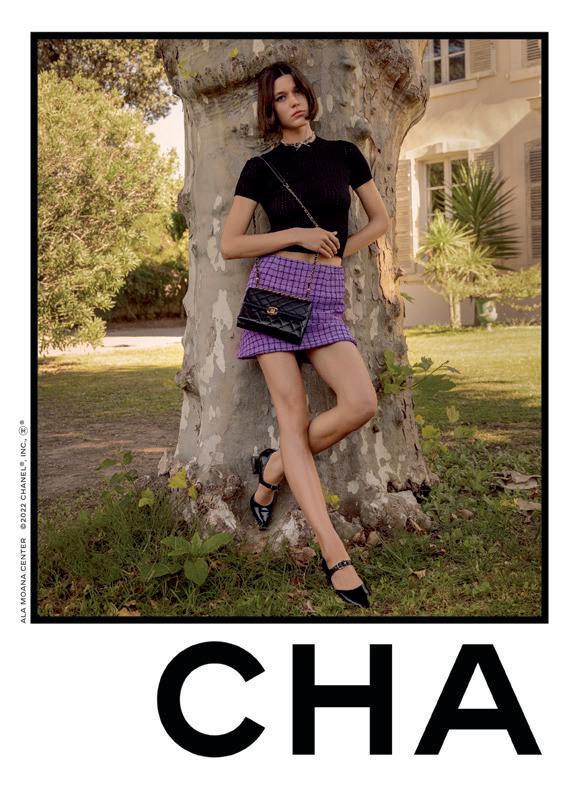


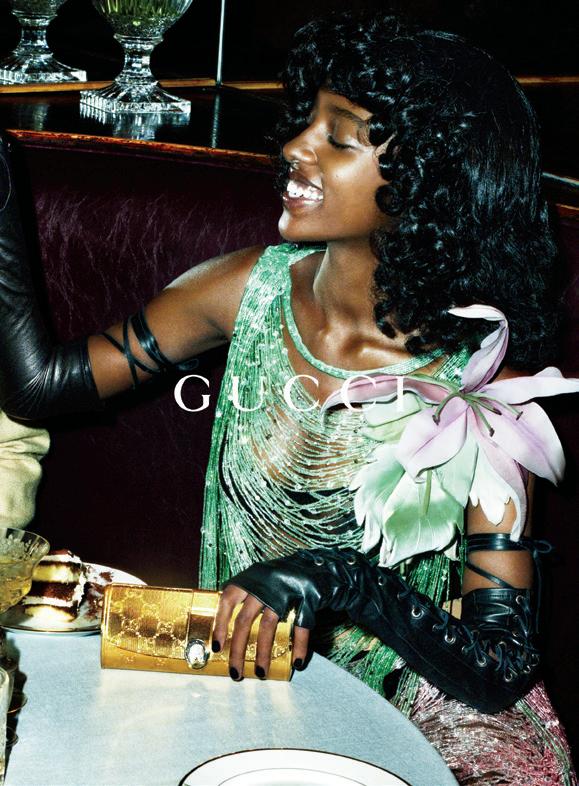




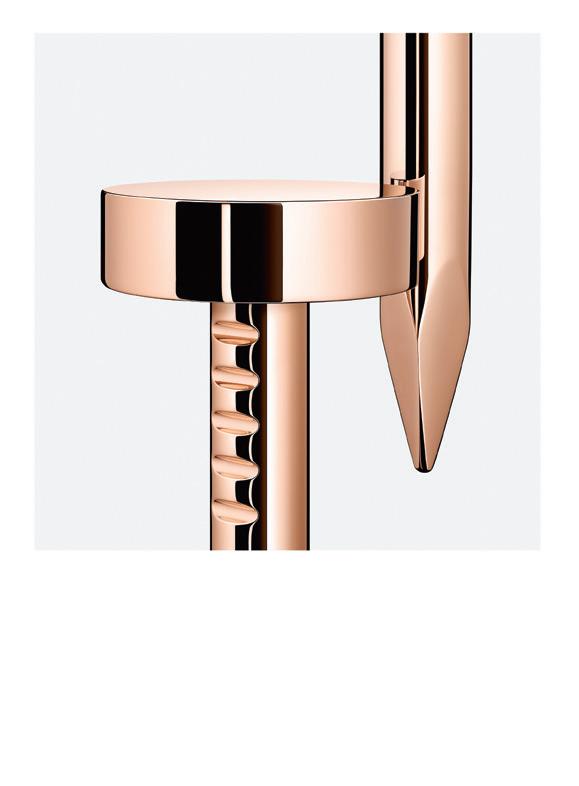

TABLE OF CONTENTS
FLUX PHILES
24 | Surfing
Carissa Moore
34 | Activism
Women Cross DMZ
40 | Cuisine
Merienda
46 | Maoli
Kapūkaki
56 | Arts
Jack Soren
64 | Environment
Mā‘ona Community Garden
A HUI HOU

FEATURES
168 | Rooftop 102 N. Hotel 72 | A Written Movement
Delve into the origins and generational influence of Bamboo Ridge Press, which continues to nurture Hawai‘i writers and preserve their literary legacies.
80 | Creators of Kapa
Nanea Lum and Lehuauakea, two creative contemporaries who bring a modern lens to their respective artforms, discuss kapa making, colonial institutions, and the hardbitten truths of being a contemporary Kanaka Maoli artist.
92 | Sliding Giants
The monstrous waves at Pe‘ahi are not for the faint of heart. But for those who find the courage and strength, a sense of triumph and euphoria follow in their wake.
104 | Letters to Paradise
If you could send a message back in time to the year 2020, what would you write? We asked local luminaries to offer handwritten words of comfort and insight to a Hawai‘i just at the start of the pandemic.
112
| This Elusive Light
A bright narrative of the islands shines through in the imagery of photographer Michelle Mishina.
|
|
FEATURES
S/S 2022
10 | FLUXHAWAII.COM
Image courtesy of Lehuauakea
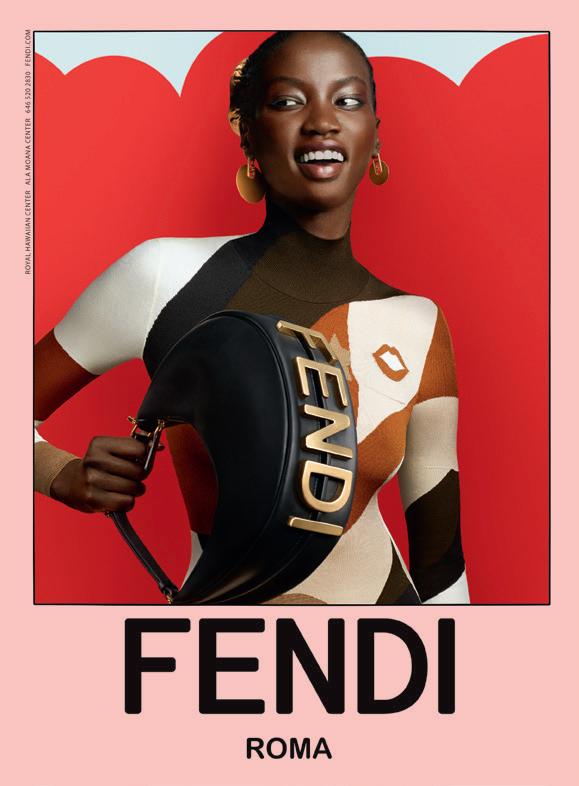

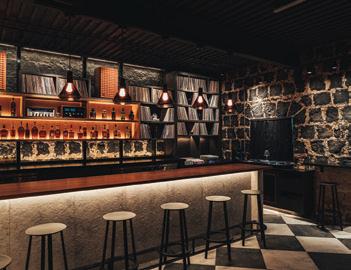
152 LIVING WELL 154 | Architecture Hawai‘i Non-Linear 162 | Ceremony Chado 124 EXPLORE 126 | Dining Okazuya and Vinyl 134 | Media Nūpepa 142 | Culture Lei Makers TABLE OF CONTENTS | DEPARTMENTS |
Image by Mark Kushimi
12 | FLUXHAWAII.COM
Image by John Hook


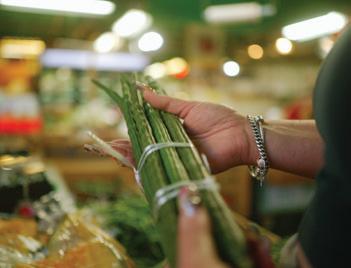
Stay current on arts and culture with us at: fluxhawaii.com /fluxhawaii @fluxhawaii @fluxhawaii INFLUX TV
TABLE OF CONTENTS | VIDEO | Still from IN FLUX Still from IN FLUX 14 | FLUXHAWAII.COM
Renko Floral Alien Arrangements
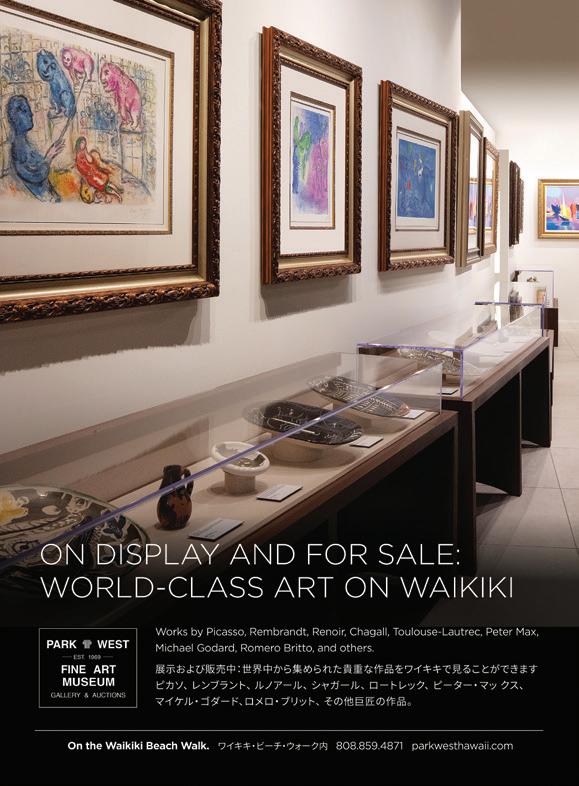
On the Cover
Three images highlighting stories from inside the issue. Clockwise from right: 1.) Hāehu Masau Lee at Honokea Loko I‘a, at Waiuli in Keaukaha, Waiākea Ahupuaʻa, Hawaiʻi Island, photographed by Michelle Mishina; 2.) Hawaiianlanguage editor N. Ha‘alilio Solomon at Hawaiian Mission Houses in Honolulu, photographed by Mahina Choy-Ellis; 3.) Kapa artist Lehuauakea, photographed by Moriel O’Connor.



Streaming Videos, Newsletters, Local Guides, & More
We’ ve refreshed the website for Flux Hawaii with a more dynamic viewing experience. Watch all the original episodes from our themed seasons, find ways to support local small businesses, and sign up for our weekly newsletters curated with fascinating reads. You can also browse past issues of the print magazine for purchase.


FLUXHAWAII.COM
TABLE OF CONTENTS | ONLINE |
16 | FLUXHAWAII.COM

PUBLISHER
Jason Cutinella
VP BRAND DEVELOPMENT
Ara Laylo
EDITORIAL DIRECTOR
Lauren McNally
EDITOR-AT-LARGE
Matthew Dekneef
DIGITAL EDITOR
Eunica Escalante
SENIOR PHOTOGRAPHER
John Hook
PHOTOGRAPHY EDITOR
Samantha Hook
DESIGNERS
Nico Enos
Mai Lan Tran
CONTRIBUTORS
Sarah Burchard
Kahikina de Silva
Viola Gaskell
Naz Kawakami
Lindsey Kesel
Tony Kile
Kai Lenny
Jon Letman
Timothy A. Schuler
Rae Sojot
N. Ha‘alilio Solomon
Kylie Yamauchi
IMAGES
Kara Akiyama
Mahina Choy-Ellis
Ronit Fahl
Mitchell Fong
Viola Gaskell
Mark Kushimi
Niana Liu
Michelle Mishina
Taylor Oishi
Jen May Pastores
Josiah Patterson
Chris Rohrer
CREATIVE SERVICES
Marc Graser VP GLOBAL CONTENT
Gerard Elmore VP FILM
Blake Abes
Romeo Lapitan
Erick Melanson FILMMAKERS
Jhante Iga VIDEO EDITOR
Kaitlyn Ledzian BRAND & PRODUCTION MANAGER
OPERATIONS
Joe V. Bock PARTNER/GENERAL MANAGER – HAWAI‘I joe@NMGnetwork.com
Francine Beppu VP INTEGRATED MARKETING francine@NMGnetwork.com
Gary Payne
VP ACCOUNTS RECEIVABLE
Tim Didjurgis OPERATIONS DIRECTOR
Brigid Pittman DIGITAL CONTENT & SOCIAL MEDIA MANAGER
Sheri Salmon CREATIVE SERVICES MANAGER
Codey Mita SALES & MARKETING COORDINATOR
ADVERTISING
Mike Wiley VP SALES mike@NMGnetwork.com
Kristine Quine SALES STRATEGY DIRECTOR
Courtney Asato MARKETING & ADVERTISING EXECUTIVE
Nicholas Lui-Kwan ACCOUNT EXECUTIVE
Taylor Kondo BRAND PRODUCTION COORDINATOR
General Inquiries: contact@fluxhawaii.com
PUBLISHED BY:
Nella Media Group 36 N. Hotel St., Ste. A Honolulu, HI 96817
©2008–2022 by Nella Media Group, LLC. Contents of FLUX Hawaii are protected by copyright and may not be reproduced without the expressed written consent of the publisher. FLUX Hawaii assumes no liability for products or services advertised herein. ISSN 2578-2053
MASTHEAD | SPRING/SUMMER 2022 | 18 | FLUXHAWAII.COM


Mitchell Fong
Mitchell Fong is an artist, designer, and illustrator raised on the windward side of Oʻahu. He attended the University of Hawaiʻi at Mānoa, where he received his Bachelor of Fine Arts degree in graphic design and served as associate design editor at the student-run newspaper Ka Leo. He has a background in editorial design, drawing, and marketing, and has done work for places including Uniqlo and NMG Network. For this issue, on page 72, Fong created the illustrations for a feature on the origins of the beloved local literary journal Bamboo Ridge. “When I was making my drawings, I envisioned the existing local narratives that Bamboo Ridge was cataloging as interwoven of fishing lines,” he says. “This was both a nod to the journal’s fisherman namesake and something that I believe captured what Bamboo Ridge was doing— untangling the stories from the talk-story ether.”
 Viola Gaskell
Viola Gaskell
Viola Gaskell grew up in Hāna, a rural town in remote East Maui, where her family grew macadamia nut and banana trees and kept chickens. Over the last seven years, she worked as a multimedia journalist in the U.S. and Asia, mostly in Hong Kong, where she reported on the city’s protest movement for an international press agency and publications like The Independent, Vice, and Al Jazeera. For others, she produced stories on a wide range of subjects, from Japan’s bread fandom to design preservation in China. In 2021, she returned to Maui, where she is now a freelance writer, photographer, and editor. Gaskell is thrilled to be reacquainting herself with her home and writing about Hawaiʻi’s moves towards selfsufficiency and reclamation of culture. In her first story for Flux Hawaii, Gaskell covered a triad of sustainable lei makers, on page 140. “For me, lei means love — that I love the person I am bestowing with lei, and that I am loved when I am given lei,” she says. “When I moved home after 12 years away and had my first art show on Maui, I was covered with lei from friends and family and it truly felt like an embrace made from the plants they’d grown and foraged, imbued with their ingenuity and affection. It really set that show apart for me.”

 Lindsey Kesel
Lindsey Kesel
Naz Kawakami is a 26-yearold Hawaiian journalist based in New York City, and specializes in the culture and economics of music, film, and social issues relating to the Central Pacific. He graduated with a bachelor’s in creative writing from the University of Hawai‘i at Mānoa, where he served as a programmer and news director for radio station KTUH. For a couple of glorious, unadulterated years circa 2017, he was the editor in chief of NMG Network’s creepy little cousin, Chinatown Now, where he showcased artists, musicians, and institutions of the historic district, as well as throw elaborate parties under the guise of “editorial research.” In this issue, Kawakami spoke with artist Jack Soren, on page 56. “I was refreshed by his sense of confidence and comfort in admitting that he isn’t perfect and is confronted by these contradictions without having a formalized answer for how to reconcile them,” Kawakami says, of interviewing Soren. “Where most seem to feel the need to have arrived at cultural postcolonial enlightenment, Jack is interested in learning and being on that journey and seems to view it as a never ending process. He is working on it, and he is okay with that. I liked that.”
Based in Bora Bora, French Polynesia, Lindsey Kesel keeps a strong connection to Hawai‘i through storytelling for publications by NMG Network. In 15 years of living in Honolulu, Kesel parlayed her experience creating content for agencies, businesses, and nonprofits into a new iteration of writing career: exploring the souls and spaces that enrich local landscapes. Her favorite topics are sustainability and nature, the arts and artists, Hawaiian and Pacific Island culture, makers and changemakers. Her past stories for Flux Hawaii include a feature on O’ahu’s female lifeguards and a review of legendary artist Ai Weiwei’s canon. On page 64, she shares the journey of a Hawai‘i Island community garden. The shift in mindset that happens to many garden visitors left a lasting impression on the writer. “Here’s this modest 5-acre space where a small group of volunteers are rallying the community around massive waste diversion efforts like shredding a ton of cardboard a month,” Kesel says. “People learn that the go-to option of recycling involves a fossilfuel-eating boat ride to Asia, and instead they get to see their scraps being used right here, right away as fertilizer. That stays with them forever.”
CONTRIBUTORS |
SPRING/SUMMER 2022 |
Naz Kawakami
20 | FLUXHAWAII.COM

 Carissa Moore is the first female Olympic gold medalist for surfing. Image by Steven Lippman.
Carissa Moore is the first female Olympic gold medalist for surfing. Image by Steven Lippman.
ARTS & CULTURE
“We want to give people permission to look around at their community and ask, ‘How can we do better with what we have?’ Because no one is more powerful than you and I.”—Chantal Chung

The Reign of Carissa Moore
The Kānaka ‘Ōiwi athlete didn’t just witness Duke Kahanamoku’s wish of seeing surfing become an Olympic sport: she won gold. Now, as surfing’s first female Olympian to medal, Carissa Moore reflects on what’s next.
TEXT BY KYLIE YAMAUCHI
IMAGES BY JOHN HOOK AND STEVEN LIPPMAN COURTESY OF RED BULLETIN
In July 2021, Carissa Moore found herself far from the world-class, crystalline waves she’d come to love and master in her hometown of Honolulu. More than 4,000 miles away in Chiba, Japan, the 28-year-old professional surfer represented the United States in the 2021 Olympics and its debut surfing competition.
An impending typhoon, gloomy skies, and angry currents at Tsurigasaki Beach served as constant reminders that Moore was out of her comfort zone on finals day, as she went up against Bianca Buitendag from South Africa.
To add to the pressure, Moore, who is Native Hawaiian, was following in the footsteps of another homegrown icon Duke Kahanamoku, a three-time Olympic gold medalist in swimming and the father of modern-day surfing. With all of Hawai‘i cheering her on, Moore won her heat, becoming the first woman to win Olympic gold in surfing.
Now back home on O‘ahu, and on the heels of a newly unveiled 150-foot Honolulu mural by artist Kamea Hadar that depicts Moore alongside Kahanamoku, she recounts that historic day, everything that has transpired since, and the meaning of aloha.
Carissa Moore started surfing with her dad at Waikīkī, where she would pass by Duke Kahanamoku’s statue daily. Right, image by Steven Lippman.

FLUX PHILES | SURFING | 24 | FLUXHAWAII.COM

FLUXHAWAII.COM | 25

First off, I want to say congratulations on your Olympic gold medal. Thank you so much!
I was rewatching your finals heat and saw that you had the biggest smile on your face, even before you got into the water. What was that day like for you? The whole Olympic experience was new and uncharted territory. For me, it was finding that balance between wanting to do well in the contest and giving everything I had, and letting go and enjoying the experience.
On final’s day, there were crazy conditions because of the typhoon—a lot of water moving, a lot out of my control. So I surrendered to the universe: Whatever’s going to be is going to be. I’ll give my very best and surf from my heart and we’ll see what happens. I’m very grateful, because I felt very present in that moment and enjoyed every second of it.
Did it feel any different from when you competed on the World Surf League Championship Tour?
All I’ve ever known is competing on the
Championship Tour (CT), so I didn’t know what this [Olympic event] would be. It did feel different in the fact that the contest setup was massive and without fans. Also, there’s different luxuries that come with the CT. Sometimes when there’s a lot of water moving, we get jetski assistance.
I feel like the first twenty minutes of the final’s heat was just you and Bianca paddling out.
(Laughs) I just get exhausted thinking about it. I was so tired! Before paddling out, I remember having a conversation with my dad and he said, “It may not feel like things are going your way, but just keep going, because something will work out.”
Having competed with Caroline Marks, John Florence, and Kolohe Andino on tour, what was it like to represent Team USA together?
I really enjoyed being a part of the team spirit, because surfing, for the most part, is an individual sport. Caroline is one of my biggest competitors, normally. I
From O‘ahu, Moore represented the United States in the 2021 Olympics and the event’s debut surfing competition. Above, image by Steven Lippman. Opposite and overleaf, images by John Hook.
26 | FLUXHAWAII.COM
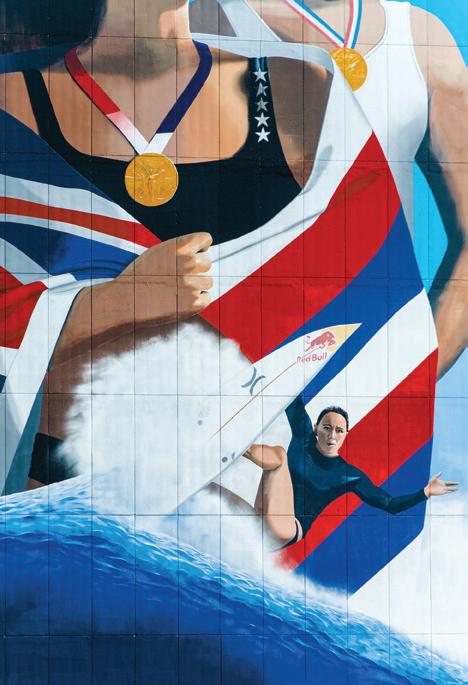


honestly thought she was the one to beat in the Olympics, especially when the conditions were smaller because that’s what she grew up surfing in Florida. I was literally staying and living in the house with the surfer I wanted to beat the most. (Laughs.)
Having surfed on tour since 2010 and with five women’s world titles under your belt, you’re no stranger to competing and competing well. Going into this prestigious, international sports event, did your mindset and goals shift in any way?
I definitely drew inspiration from my normal formula. One of the things that was unique to this event was the wave. [Surfing in Chiba] took calmness and simplicity. For the most part, you’re not worrying about your opponent; you’re playing your own game.
As a Kānaka ‘Ōiwi Olympian, you’ve been compared to the legendary Duke Kahanamoku. Going into the Olympics, how did his legacy influence you? It’s a lot to be mentioned in the same sentence as Duke, because he’s a legend and he’s been one of my role models. I grew up surfing Waikīkī and passing by his statue every day. His legacy is beautiful. It’s about treating people with kindness and sharing what you have without wanting anything in return. He had the biggest heart. I think he was an incredible athlete, Olympian, and waterman as well.
It’s neat because before the Olympics, I had the chance to watch a documentary on him. Watching his backstory helped me to realize what it means to be a Native Hawaiian and to represent our people the best I can. This was his dream for surfing to be in the Olympics. I wanted to make Hawai‘i proud. I wasn’t going into any normal surfing event. It was about something bigger than me.
I saw on Instagram that you were able to view Kamea Hadar’s mural of you and Duke up close and personal. Despite your fear of heights, what was your reaction to seeing the mural? Honestly, just blown away. They told me this was happening, but I didn’t realize it until I was standing in front of it. It’s such an honor to have someone paint my face on a giant wall and next to one of my heroes. I definitely want to do the best that I can with my platform to send my love and hopefully continue Duke’s legacy of the aloha spirit.
Kamea did an absolutely stunning job. I can’t even grasp how he’s able to translate a small picture on a paper to a wall that size. I’m afraid of heights, he’s afraid of heights! (Laughs.) How does he stand up there all day and paint?
It was really cool getting to know Kamea too. He puts so much effort into his work. He did a lot of research into Duke’s medal. He even looked up the ribbon that the medal hung on, which is different from mine. There are so many different meaningful things in what he did. So much research, love, and time he put in. I’m blown away all around by the love from my community. It’s been heartwarming and special.
Being from Hawai‘i, my dad and I love watching you surf especially because you always show the aloha spirit both on and off camera. What does aloha mean and look like to you? It’s a big question. I think aloha to me is love. I feel so fortunate to have grown up in Hawai‘i surrounded by the aloha spirit. My family goes beyond my blood. It’s the people I see every day in the water, the people who say hello or ask how I’m doing. Those little interactions

30 | FLUXHAWAII.COM

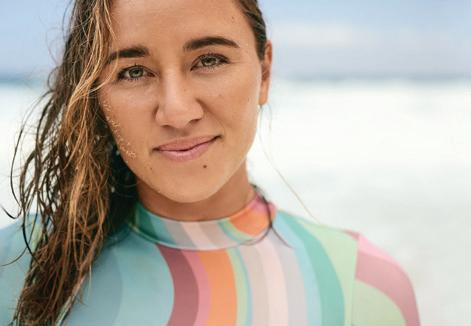
I have found really make a difference. My biggest heroes have definitely done incredible things in their sport or achieved great things in their life, but it’s who they are as people—that they’re real, tangible, and caring. That’s the stuff that lasts. You can win an event, but tomorrow it’s on to the next thing. I’ll always remember how people made me feel. So, that’s love, that’s aloha.
Can you speak more on Moore Aloha and where this idea came from?
I started my charitable foundation Moore Aloha three years ago. I was inspired by Hurley Surf Club, which organized events at local beaches and invited the community of kids to come down. They’d have one of their pro surfers do a session and mentor. I did one at Kewalos. There were 30 girls with big wide eyes, ready to absorb any sort of information. As much as it was about giving to them, I felt that I got so much more in return from their smiles and joy and excitement. It was so refreshing and beautiful. I always wanted
to find a way to give back, so this felt like my aha moment.
I know how hard it is as a young woman in this day and age. There is so much that can take away from us being our most authentic self. So how could I make a day where girls feel inspired to be themselves, share, create, and encourage? I’ve been at the top before where I haven’t had any friends and it’s really lonely. The goal is to help these girls do what they love and give love along the way.
Now that you’re an Olympic gold medalist, what goals do you have yet to accomplish?
I’m actually in the midst of my brainstorming and goal setting right now. There’s a lot of performance goals I have with surfing, and I’d like to continue with my non-profit. At some point — I don’t know when it will happen — I’d love to be a mom one day! That’s definitely a goal for the future.
This interview has been edited for length and clarity.
A 12-story mural by Kamea Hadar in honor of Moore and Kahanamoku is located at King and Pensacola streets. Above and previous page, images by Steven Lippman.
Learn more about Moore Aloha and its empowering surf camps at moorealoha.com.
32 | FLUXHAWAII.COM

Breaking Borders
In the documentary film Crossings, international activists mobilize the charge toward peace on the Korean peninsula. A Honolulu organizer highlights how Hawai‘i can play a key role.
TEXT BY JON LETMAN
IMAGES BY NIANA LIU AND JEN MAY PASTORES
On our war-wounded planet, some conflicts are acute, some chronic, and still others defy simple diagnosis. Nowhere is this truer than the Korean peninsula where, for more than 70 years, a divided nation remains in a state of war.
From 1950 to 1953, a brutal war took place on ground and air between the Democratic People’s Republic of Korea in the north, backed by China, and the Republic of Korea in the south, backed by the United States. This war inflicted death and destruction, causing millions of mostly civilian casualties. A 1953 armistice signed by the United Nations Command, China, and North Korea halted active fighting, but a formal peace treaty was never concluded, leaving Korea in a technical state of war.
Today the Korean peninsula remains divided by a demilitarized zone, or DMZ, which is, in fact, one of the most militarized places on Earth. Previous attempts to cross the DMZ have been met with immediate arrest or death, but a 2015 crossing by a group of 30 women from 15 countries suggests another future is possible.
This peace effort is documented in Crossings, a 2021 documentary directed by Deann Borshay Liem had its world premiere at the Hawai‘i International Film Festival. The film follows the transnational feminist group, now known as Women Cross DMZ, as they travel from Beijing to the Democratic People’s Republic of Korea to meet with North Korean women, then cross into the Republic of Korea to meet their counterparts in the south.
After multiple visits to North and South Korea, Christine Ahn, a Korean American peace activist based in Honolulu and founder of Women Cross DMZ, concluded that the participation and leadership of women was key to bringing peace to the peninsula. That required meeting with the people who were “supposed to be her enemy.”
Informed and inspired by decades of work by Korean women on both sides of the divide, Ahn points to studies that prove women-led peace efforts are stronger and more durable. Women Cross DMZ had three ambitious goals: replace the armistice with a peace treaty; reunite Korean families; and elevate women’s leadership in the peace process.
In May of 2015, the 30 women, accompanied by filmmaker Liem and a crew of three, flew to Pyongyang to seek dialogue, understanding, and a chance to end the so-called “forgotten war.” The group was comprised of women from South Korea, Asia, Africa, Oceania, the Americas, and Europe. Delegates included Nobel Peace laureates Mairead Maguire and Leymah Gbowee, feminist organizer Gloria Steinem, members of CODE PINK, activists, educators, and leaders who could work across ideological and political lines.
While in North Korea, the group met women in a textile factory, a kindergarten, a maternity hospital, as well as at formal meetings and a symposium. In one scene, a Korean war survivor wept as she described both her hands being shot off by an American soldier during the war, her bitter
From the documentary Crossings , directed by Deann Borshay Liem. Still by Niana Liu.
FLUX PHILES | ACTIVISM | 34 | FLUXHAWAII.COM


memories still raw and mercilessly vivid.
Liem said her crew was allowed to film almost without restriction. They documented women working to dispel years of mistrust and fear, sharing their struggles and aspirations, and recognizing their common humanity. In a moment of striking candor, one young North Korean woman— an interpreter—told the women, “We are against [the U.S.] hostile policy towards the DPRK. We are not against the U.S. people.”
The visit took place during the administration of South Korea’s thenconservative president Park Geun-hye, and not everyone appreciated their efforts at rapprochement. As news of the trip spread, the women were vilified by some in South Korea as “North Korean sympathizers,” “propogandists,” and worse. They were chided for being naïve despite their collective decades of addressing war and conflict from Northern Ireland and Liberia to Okinawa, Zimbabwe, Colombia, Gaza, Iran, and elsewhere.
On May 24, 2015, the day the women crossed the DMZ, they received an ebullient
sendoff by throngs of North Korean women wearing Chosŏn-ot (Hanbok), traditional dresses of plum pink, sky blue, and golden yellow, and waving bright red floral wands. Large banners read “Let us reunify the divided country as soon as possible!” But tensions at the DMZ were high and the air was heavy with uncertainty about what awaited them to the south.
Initially, the women planned to walk across the border at the Joint Security area (Panmunjom) where Donald Trump and Kim Jong-un stepped over the military demarcation line in 2019, but crossing on foot was politically sensitive and the US-led UN Command, which controls the South Korean side of the DMZ, insisted they enter by bus at the nearby Kaesong border crossing.
Upon arriving in South Korea, the women were met by reporters, some of whom challenged their motives. Several in the group were threatened with deportation, and all faced right-wing protesters, many of them North Korean defectors, with signs reading “Return to North Korea!” and “Women Cross go to hell.” That didn’t stop
The film follows the transnational feminist group, now known as Women Cross DMZ. Still by Niana Liu.
Learn more about the organization and their efforts at mufilms.org.
36 | FLUXHAWAII.COM
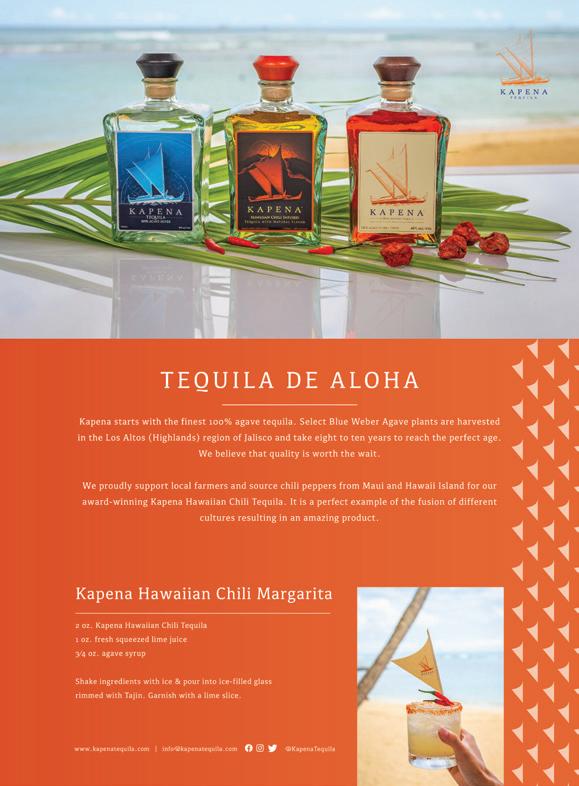

the group from crossing Tongil (Unification) Bridge where they were welcomed by South Korean supporters waving balloons and singing songs. South Korean committee member Jin Ok Lee said of the peace walk, “I think [it] sparked the revitalization of women’s peace movement in South Korea.”
Recalling her visit to North Korea in Crossings, Liberian Nobel Peace laureate Leymah Gbowee said, “This is a place in my mind where there was no life, but you see the yearning for greater connection with the rest of the world. Five thousand women showed up and saw 30 international women. I believe it gave them hope.”
Six years after that trip, following Trump’s whiplash diplomacy which jerked between “fire and fury” and “love letters,” U.S.-Korean diplomacy is more muted. But the Biden administration has retained policies Ahn calls “regressive and draconian,” such as sanctions and a travel ban.
Speaking from her home in Honolulu, Ahn said, “I do feel like Hawai‘i can play a really critical role in ending the 70-year-old
conflict, moving the U.S. from this stuck, broken, failed policy of maximum pressure, sanctions, and military aggression towards a different approach.”
She pointed to the Korean War Divided Families Reunification Act, co-introduced by Hawai‘i’s Sen. Mazie Hirono in 2020 and again August 2021, and Rep. Kai Kahele’s co-sponsorship of a U.S. House resolution calling for peace on the Korean peninsula. Ahn hopes all of Hawai‘i’s congressional delegation will play a more active role promoting peace for Korea. Ahn also hopes the film will encourage people to join a movement of those who recognize that peace in Korea offers security for Hawai‘i too. For all who experienced the 2018 false ballistic missile scare, that connection is not an abstraction.
If the DMZ is a place of separation and tragedy, Crossings shows it can also be a place of hope and one from which the healing from the sickness of war and division that has beset Korea can begin.
Protests were held around the United States in response to the spike in violence against the Asian American community. Image by Jen May Pastores.
Read an op-ed by Christine Ahn, the founder and executive director of Women Cross DMZ, on addressing the long legacy of imperialism and ending anti-Asian violence at fluxhawaii.com.
38 | FLUXHAWAII.COM

Afternoon Delights
How the nostalgic ritual of merienda, a midday snack-break and Filipino favorite, satiated one writer’s inner child.
TEXT BY EUNICA ESCALANTE
IMAGES BY JOHN HOOK
As a kid there was no other time of day that I cherished as deeply as merienda, the point in the afternoon specially reserved for a midday nosh. In the Philippines, it’s usually comprised of a light meal, practically a snack, taken at some point between lunch and dinner. But don’t let merienda’s casual nature fool you. Blasé it may be, irrelevant it is not. It is the country’s unofficial fourth meal, as well-established as breakfast, lunch, and dinner. And with a category of dishes all its own, they claim some of Filipino cuisine’s greats, from street food to desserts.
It may seem frivolous, perhaps even infantile, to hold snacking in such high regard. And yet! In my formative gastronomic memory, merienda brings the main character energy: a perfectly caramelized turon on the way home from the market; a warm and pillowy pan de sal for an after-school snack; a cup of halo-halo as a reprieve from the summer heat.
None of these dishes were essential for sustenance. Unlike its meal-time contemporaries—the more legitimate trio of breakfast, lunch, and dinner—merienda isn’t necessary for a day of well-rounded nutrition. So, the question arises: If not for survival, what higher purpose does merienda serve? Why is it so ubiquitous and beloved that it’s not only bequeathed a name, distinguishing it from the day’s other meals, but also bears its own distinctive cuisine?
Merienda isn’t exclusive to the Philippines. It came to the islands by way of Spanish conquistadores, who in turn inherited it from their Roman predecessors. It can be found in some form across countries and cultures. In Portugal and Italy, it’s known as merenda; in Brazil, lanche. Then, there is the French goûter, Swedish fika, Russian poldnik. Let’s not forget the Brits and their afternoon tea. In an age when no one can seem to agree on anything, the urge to snack may be among the last that we have in common.
Merienda’s etymology traces its roots to merere , the Latin for “to earn or deserve.”

FLUX PHILES | CUISINE | 40 | FLUXHAWAII.COM
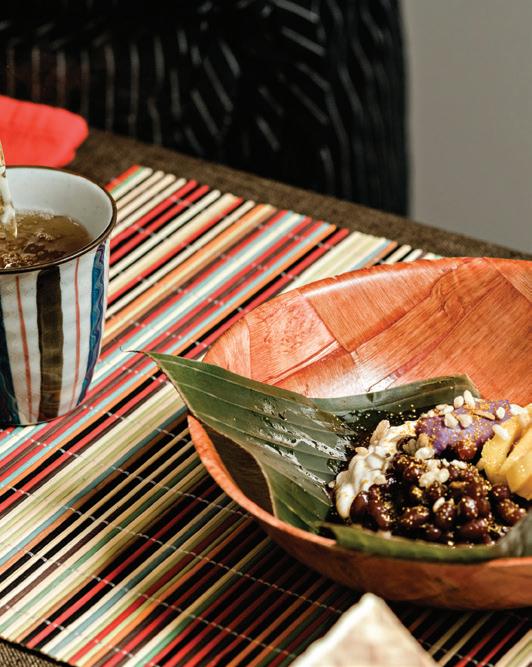
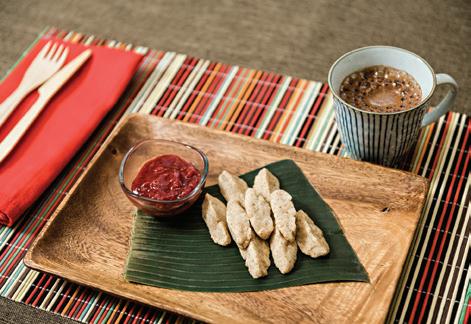
Across centuries and cultures, the conditions of a merienda are mutable. The time of day, length, and dish can vary based on the particular needs and wants of the merienda taker. But, its basic conceit remains the same. While not depended on for physical nourishment, the practice still satiates a hunger of a different kind: It is a comestible respite. A moment of rest and relaxation presented on a platter. An intermission from the grueling production that is daily life—pūpū and drinks provided. I’m being melodramatic, I know. But, why else is the concept so universal?
Now, this is the point when I reveal the third-act plot twist of this piece. For all my endless pontificating about merienda, it has only recently become a part of my own daily routine. While I vividly remember afternoons spent meriendaing, it encompassed just a fraction of my childhood. Upon emigrating to the United States at the age of nine, merienda became a vestige of my former life in the Philippines, one of the relics washed away amid the wave of cultural assimilation.
Besides, the modern-day American workplace has no stomach for an act as leisurely indulgent as merienda. To take another hour away from one’s work for a simple snack-break feels like a repudiation of the grind for the American Dream. To be successful you must be productive. To be productive you have to be efficient. And to be efficient means to favor output above all else, ignoring even your most basic human needs for company, for contentment, for a moment to breathe. At no point has this been more prominent than today, when the pandemic has blurred the boundaries between work and everything else.
One afternoon in January, I took a tasting with chef Jo Seoung, the one-woman team behind Wow Baguio, an all-vegan shop for handcrafted snacks that in the year since its inception rapidly became a local purveyor of authentic Filipino treats. A fellow journalist recommended that I try her Taste of Cordillera menu, an intimate tasting experience that Soeung offers alongside her ready-made treats, inspired by her childhood in the Philippines’s Benguet
Merienda isn’t necessary for a day of well-rounded nutrition, but some might argue it serves a higher purpose.
42 | FLUXHAWAII.COM

FLUXHAWAII.COM | 43

Province. To my delight, the three-course affair consisted entirely of—wait for it— merienda dishes. Right then and there, that little word, “merienda,” ignited an instant response in me, like a child hearing the tinny melody of an ice cream truck. At the tasting, each bite was a Proustian experience, triggering nodes of childhood memories. There I am, five years old and on my father’s lap as he delicately peels the thin banana leaf wrapping off of suman malagkit, a sweet sticky rice and coconut milk confection, before dipping it into a bowl of sugar, coating its glutinous exterior with a thousand sparkling crystals. I am eight and freshly home from school, a daily pilgrimage that requires my mother and I to pack ourselves into a cramped jeepney, our skins sweaty and sticky from exhaustion amid the humidity. For our efforts, she rewards the two of us with a spread of pan de sal, each light and airy bun packed with a tangy mayonnaise spread, a tantalizing cup of Coca-Cola always within reach. There is something comforting about preparing a platter of snacks for oneself—
and I don’t mean grabbing a handful of nuts on the way back to your desk or swiping a bag of chips to mindlessly munch on while working. The nostalgic ritual of a midday break itself feels like a return to my childhood, when the day’s idle moments could be delightfully interrupted by a conspiratorial whisper of, “Tara, merienda tayo.” Come on, let’s have merienda. An invitation to leave the day as it lays, at least for a little while, and enjoy an unbidden moment of respite.
Merienda’s etymology traces its roots to merere, the Latin for “to earn or deserve.” Growing up, merienda was seen as a treat, doled out to children who behaved, which might explain my almost Pavlovian response to it. These days, as the clock ticks over to the afternoon, I’ll feel the siren song of merienda calling to adult-me. The crushing expectations of the day lessens, albeit marginally. And my inner child reassures me: “Go on, have some merienda. You deserve it.”
Chef Jo Seoung is the onewoman team behind Wow Baguio, an all-vegan shop for handcrafted snacks that became a local purveyor of authentic Filipino treats.
Learn more about this pasalubong shop at wowbgo.com.
44 | FLUXHAWAII.COM

“He Kaua Kuana‘ike Kēia”: E Kū Ana ma nā Lālani Mua Loa me Kalehua Krug
Ke ho‘okikina mai nei kekahi alaka‘i lāhui Hawai‘i i nā hoa make‘e pono—i “nā mea a pau ho‘i e aloha nei iā Hawai‘i”—e maka‘ala mau.
NĪNAUELE ‘IA NA N. HA‘ALILIO SOLOMON
PA‘I KI‘I ‘IA NA JOSIAH PATTERSON
ʻOiai he mau makahiki lōʻihi ke kūʻē ʻana i ko Red Hill
Bulk Fuel Storage Facility o kekahi mau ʻahahui kūloko e ʻimi mau ana i ka pono o ka ʻāina, ʻaʻole naʻe i ulele mai nā keʻena mana o ka mokuʻāina i ka hana hoʻoponopono ʻana a hiki i ka wā i maʻi ai kekahi o nā kamaʻāina, me ke hoʻokomo pū ʻia i loko o ka haukapila. E like me ia kūʻē
ʻana, he lōʻihi ke kānalua ʻana iho o kekahi mau ʻahahui makeʻe ʻāina i ke ʻano a ko ʻAmelika Huipūʻia pūʻali koa e hana nei i ka ʻāina. No laila i ʻeu aʻe ai ʻo Kalehua Krug i ka hoʻolaha ʻana aʻe nei he kuanaʻike Hawaiʻi i wahi e alakaʻi ai i ka mālama pono ʻana i ka ʻāina; ʻo ke Poʻo Kula ʻo Krug no Ka Waihona o Ka Naʻauao, he kula hoʻāmana Hawaiʻi; he kākau uhi; he hoʻokani pila, puʻukani, a he haku mele hoʻi. He lālā pū hoʻi ʻo Krug no Kaʻohewai, ka hui nāna i kūkulu he koʻa ma ka ʻīpuka mua o ka Headquarters Commander of the U.S. Pacific Fleet, kahi a lākou e lawelawe mau ana he mau ʻaha hoʻomanamana Hawaiʻi, i loaʻa ai he kuanaʻike Hawaiʻi ma ona lā hoʻi e kūʻē ai i nā pahu kakalina nui a ka ʻOihana Moku he iwakālua e waiho nei ma lalo o ka ʻāina.
I Dekemaba nei, ua noho ʻo Krug me Flux Hawaii ma Pauao, e kūkā kamaʻilio ai no ka huliamahi ʻana o ka poʻe he mau makahiki lōʻihi ma ka ʻaoʻao o ka pono, aia hoʻi ma Kapūkaki, e kapakapa mau ʻia nei ʻo Red Hill, a no ka hoʻolana ʻana hoʻi i ko kākou mau manaʻo.
Ke kūpa‘a nei kekahi po‘e ma hope o ka pono o ka ‘āina ma Kapūkaki (Red Hill), no ka ho‘oma‘ema‘e ‘ia ‘ana o ka wai ma laila i haumia ma muli o ka hana hāwāwā na‘aupō o ka ‘Oihana Moku o ‘Amelika Huipū‘ia.
46 | FLUXHAWAII.COM FLUX
| MAOLI |
PHILES

FLUXHAWAII.COM | 47

HA‘ALILIO SOLOMON Aloha mai, e Kalehua. E wehewehe iki mai ʻoe i kā ʻoukou hana ma Kapūkaki. He koʻa, ʻōlelo mai nei ʻoe, he koʻa, a, he aha kona ʻoihana?
KALEHUA KRUG ʻĀ ʻoia, maopopo iā kākou i ka nānā ʻana i ka puke wehewehe ʻōlelo a Pūkuʻi i waiho maila na kākou, ʻo ke koʻa, he ʻano ahu pōhaku, pōhaku poepoe a koʻa nō hoʻi, a kūkulu ʻia no ka hoʻomāhuahua ʻana i ka iʻa a manu paha. Kūkulu pū ʻia ʻo ia ma kaʻe o kahawai i ka hapa nui o ka manawa, a i ʻole ma kahi o ke kai, a ua loaʻa m aila nō kēlā, ʻoiai kūkulu ʻia kēia i mua o ka pāpū ʻoihana moku, ma ka puka mua o ka pāpū ʻoihana moku ma Kapūkaki. No laila, kūkulu ʻia kēlā koʻa ma laila, no ka mea i ka puka mua, ʻike mau ʻia he kia hoʻomanaʻo kēlā na ka poʻe kāʻalo aku no ka hihia e holo aʻe nei i kēia manawa he hihia ia o kānaka. ʻO ka mea wale nō e pōmaikaʻi ai kona kūkulu ʻia ʻana ma laila, he kahawai ko laila kekahi. No laila ke mālama ʻia nei ke ʻano o kona kūkulu ʻia ʻana, e like me ka ʻike i loaʻa iā kākou i kēia manawa. Akā, ʻaʻohe iʻa e ʻume ʻia ana, ʻaʻohe manu, inā
ʻaʻole kākou kiʻi ma ke kaona ʻo ka manu he kanaka, a ʻo ka iʻa, he kanaka. No ka mea ʻo kēlā koʻa, he mea ʻume kanaka, ʻume ola ke ʻano. E ʻumeʻume i ka hoihoi o nā kānaka e kū nō ma ka ʻaoʻao kūpono o kēia hihia e kākoʻo ai no ka holo ʻana o ke kakalina i loko o ka wai ma lalo o ka ʻāina, e puka mai ana ma nā kahawai, ma nā paipu wai, i loko o nā hale e noho ʻia nei e kekahi o nā pūʻali koa i kēia manawa. He 90,000 nā kānaka i pilikia i kēia wai i hoʻohaumia ʻia, a no laila ʻo kēlā koʻa, he koʻa kēlā e ʻume ai i ka ʻike, e ʻume ai i ka noʻonoʻo a me ka ʻālawa o ko ka lehulehu mau maka no kēia hihia, e ʻume ai i ka lāhui e kū pū me ka poʻe nāna i uhauhumu i kēlā koʻa, a kū pū ma ka ʻaoʻao … a hoʻōla ma ka ʻaoʻao e hoʻoponopono ai i kēia hihia.
HS ʻO wai ka poʻe e kū ana i mua o ka ʻaha hoʻokolokolo, e haʻiʻōlelo ana? ʻOukou, Sierra Club?
KK ʻĒ. Na kekahi mau lālā mai ke kula nui kekahi. Akā, ʻo ka poʻe aloha ika ʻāina.
Penei ke kū‘ē ‘ana o ka po‘e kūpa‘a ma hope o ka ‘āina, me ka ho‘omā‘ike‘ike pū ‘ana aku i kekahi mau hō‘ailona.
Visit fluxhawaii.com/ section/olelo-hawaii to read this story in English. This piece is part of Flux Hawaii’s Hawaiianlanguage reporting series featuring articles conceived, commissioned, and produced all in ‘ōlelo Hawai‘i, in partnership with Google News Lab.
48 | FLUXHAWAII.COM

HS ʻAe. Ma laila ka mea ʻāpiki, he mau makahiki ka hoʻolaha nui ʻia ʻana no kēia pilikia a, huli ʻia mai ʻoukou e ka pepeiao kulikuli.
KK Maʻamau naʻe. ʻO kekahi hui i hānau i loko o keia kūkulu ʻana, ʻo ia hoʻi ʻo Kaʻohewai. He hui kēnā i hui ai nā ʻano ʻoihana like ʻole, ka poʻe, kekahi mau kula, kekahi mau ʻoihana, e alu like, e hōʻike ai i ka poʻe i ke alu like ʻana ma ka ʻaoʻao lāhui Hawaiʻi no kēia hihia. No ka mea, ma mua o kēia kūkulu ʻana, uhauhumu ʻana i kēia koʻa, ʻaʻole nō i nui loa ko ka Hawaiʻi ʻōlelo ʻana e like me ka ʻōlelo ʻana no Maunakea. No laila, kini a lehu ka poʻe i kipa i ka mauna, he mauna hou kēia, ʻo Kapūkaki, e hui ai nā ihu, e hui ai nā kānaka i ke aloha i ka ʻāina.
HS I ka Pōʻalima nei, ua hālāwai ʻoukou me kekahi luna o ka ʻoihana moku?
KK He hālāwai pōkole wale nō e hōʻike aku ai iā lākou i ko mākou mau manaʻo. E like me ka maʻamau, nui ka minoʻaka, nui ka hoʻomalimali, ma ko lākou ʻaoʻao. ʻAʻole lākou — makemake wau e hilinaʻi, ua ʻoiaʻiʻo kā lākou i hōʻike mai ai, akā, i loko o ke ʻano o ko lākou hoʻomalimali ʻana, he hana nui ka hilinaʻi ʻana. A ua hana nui ka manaʻo ʻana e hilinaʻi iā lākou, ua hana nui ma mua o ka hōʻea ʻana i kēlā hālāwai. He hālāwai wale aku nō kēlā e hōʻike ai iā lākou, ʻaʻole mākou makaʻu i ka hui ʻana me lākou, mau ko mākou hoʻohuoi ʻana i ko lākou.
HS Pehea, he akua anei nona kēia koʻa?
KK ʻĀ ʻoia. No laila, ua kūkulu ʻia he kiʻi na Andre Perez mā i kālai, nani loa, e kū ana i ke kino kiʻi o kekahi mea no Kāne, i loaʻa ma Kauaʻi. Akā, ʻo ia kiʻi ke kiʻi wale nō i maopopo iā kākou ma ka Hale Hōʻikeʻike o Bīhopa, a e kū ana i ke kino i kapa ʻia no Kāne. A, no laila, ua hoʻohana ʻia kona aka, kona ʻano i mea e kū hou ai ʻo Kāne. Kāne — Kāneikawaiola. ʻO ia kēia. A loaʻa kona kahu, e kahu mau ai, ā hiki i ka hopena o ke ola. Akā, ʻo ia ʻano, loaʻa kēlā ʻano, ʻaʻole ana e mea, pahuʻa kona mālama ʻia ʻana ma hope o kēia. E mālama maikaʻi ʻia ana ʻo ia. ʻĒ, Kāneikawaiola, e kū ana ʻo ia i waena o ke koʻa, a ma kona ʻaoʻao hema, he ipu pōhaku i kālai ʻia. He pola, ʻūmeke. ʻŌlelo kekahi poʻe he ʻūmeke, ʻōlelo wau he ipu — ipu wai. Ma laila kahi i waiho ʻia ai, hānai ʻia ai ka wai. No laila, ʻo ka mea e waiho ai nāna, he wai, he hoʻohāinu.
Welo ka hae Hawai‘i ma mua iho o ke ko‘a i kūkulu ‘ia ma kahi a ka po‘e e huliāmahi nei.

50 | FLUXHAWAII.COM

HS ʻŌlelo mai nei ʻoe he kahawai ko laila?
KK ʻĒ, Hālawa. ʻAʻole nō i nui loa ka nānā ʻia o kēia hihia. A no laila ʻo ia koʻa, inā he leo kāhea ko ke koʻa, e kāhea ana ʻo ia i ko ka poʻe ʻaoʻao ʻike, no kēia hihia. A hoʻohana ʻia kēlā ma kahi o ke ahu no ka mea, ʻo ke ahu, i kekahi manawa, pono kūkulu ʻia ke ahu me ka mālama ʻole ʻia me ka maikaʻi, a ʻo ke ahu, kohu heiau lā kona ʻano, i kekahi manawa. A no laila, ua kiʻi ʻia ke koʻa no ka mea ʻo ke koʻa, he mea e ʻumeʻume ai i ke kumu waiwai, he iʻa, he manu, kēlā ʻano. Mai kahiko mai, ua manaʻo mākou ma ko mākou kūkā ʻana no ka mea e kū ai, ʻoi aku ke koʻa ma mua o ke ahu, no ka mea, ʻo ia ʻano, he aha lā hoʻi, ke ahu pōhaku hoʻomanamana, e like me ka mea e kū mau ana he māka ia no ke ahupuaʻa, a ʻo kona ʻano o ka hoʻomanamana ʻia, kohu heiau. ʻAʻole kēlā kā mākou i makemake ai. ʻOkoʻa kēia. A Kānekoʻa, ʻo ke koʻa, he kinolau na Kāne. He kino na Kāne kekahi. I ke kālailai ʻana i kekahi o ko Kāne mau inoa. No laila, ua kū i kēlā, i ka wai a Kāne, koʻa, wai. No laila holo aku nō me kēlā ko mākou noʻonoʻo ʻana ma mua o ka hoʻoholo.
HS Auē hoʻi kēia nīnau, pehea kou ʻimi ʻana i ka mea e lana ai ka manaʻo o kānaka no kēia mua aku. E walaʻau ana wau me kekahi hoa aloha no KAHEA. ʻŌlelo ʻo ia, “Easy to feel powerless,” ʻeā, he wahi komo wale kēlā e pau loa ai ka mana o ke kanaka hoʻokahi. Pehea ʻoe e hoʻolana ai i kou manaʻo?
KK ʻO ka mea wale nō, hoʻolana ʻia koʻu naʻau, koʻu noʻonoʻo ma ka mau ʻana o ka paio me ke kū ma ka ʻaoʻao pono. A no laila, wehewehe wau i ka poʻe, ʻo ia koʻa, hoʻomaka kēia ʻaoʻao o ka ʻike ma koʻu nānā ʻana i nā kiʻi akua, nā kiʻi no Kū i hoʻohele ʻia, i nauane ʻia i waena o ke anaina, ma luna o ka mauna, ma Puʻuhuluhulu, a i waena o nā wāhine, keiki, wāhine hāpai, luahine, ʻelemākule, nā mea like ʻole. A ma ka ʻike o ko kākou mau kūpuna, ua paʻa akula, ʻaʻole kēlā ka mea pololei. ʻAʻole kēlā ka mea pono. Akā, ke kiʻi nei au i kēia manawa, e kala mai, no ka poʻe heluhelu a hoʻolohe, ʻaʻole wau e hoʻohalahala nei. Ke ʻōlelo wale nei nō. He waha ʻōlelo ʻana no ka hana i hana ʻia. Ua hana ʻia kēlā, heluhelu ʻia ka moʻolelo, ʻaʻole pēlā. ʻAʻole kūlike i ka mea a Malo mā, a Kamakau mā i ʻōlelo ai.
ʻAʻole kūlike. Eia nō naʻe, ma ke kuanaʻike o ke kanaka, i mea aha ke kuanaʻike? I mea aha ka nohona Hawaiʻi? A ʻo koʻu ʻaoʻao kēia, a kaʻu e ʻōlelo mau ai i ka poʻe, ʻo ka mea nui o ka ʻōlelo, ka ʻike, ke aʻo ʻana, ka naʻauao ma kēia mau mea a pau, ma ka ʻike Hawaiʻi, ʻo ia hoʻi, ke kū ʻana o ke kanaka he lālā
no ka honua. ʻAʻole ʻokoʻa ke kanaka, ʻaʻole ʻokoʻa ka iʻa, ka makani, ka pōhaku. ʻO kēlā ʻano hoʻokanaka ʻana, ke kūkulu hoʻopili ʻana i nā mea a pau, i ia mea he kanaka — kapa inoa, walaʻau, ʻo kēlā mau mea a pau, he papahana ia e ulu ai ke kuanaʻike. A i loko nō o kaʻu mea e ʻōlelo nei, pololei, pololei ʻole, ʻaʻole wau e ʻōlelo nei i kēlā. Ke ʻōlelo nei wau, he papahana kēlā e pili ai ke kanaka i ka ʻāina. A no laila, ma koʻu kālailai ʻana i ka mea i hana ʻia ma luna o Puʻuhuluhulu, inā ʻo kēlā hana he hana Hawaiʻi, ah… ʻaʻole i like me ka mea a kūpuna mā i waiho ai na kākou, eia nō naʻe, ke nīnau aku wau i ka nīnau, inā ua ʻoi aku ka pili o kānaka i ka ʻāina ma hope o kēlā, ʻōlelo wau, “ʻAe.” He mea i ʻume i ka poʻe, a i hoʻoulu i ke aloha i nā akua, i nā kūpuna, i nā ʻaumākua, i nā mea Hawaiʻi kahiko loa. A ke loaʻa kēlā ʻano ʻike kapukapu, ah, e ʻoi aku ai ka pilina o kānaka i ka honua. E manaʻo ana au, ma laila ka lanakila. No ka mea, aia kākou ma waena o ke kaua, a ʻo ke kaua, he kaua kuanaʻike. Ke ʻano o ka noho ʻana o ʻaneʻi nei, me ka poʻe ma mua. ʻO ka poʻe ma mua, ua kūkulu lākou i ko lākou nohona no ka pono o nā mea a pau. ʻAʻole wale nō lākou i kālele ma luna o ka pono o… ka pono kānaka. A ke hoʻoholo ʻia kēlā, a he nīnau paʻakikī kēia e ʻauamo mau ai, ma nā mea a pau e hoʻoholo ai, inā kākou e pākuʻi aku i kēlā nīnau ʻana inā he mea no ke kanaka wale nō, a i ʻole no ka honua holoʻokoʻa. Noʻu nei, hoʻolana ʻia koʻu naʻau ma ia ʻano o ka noʻonoʻo ʻana. No ka mea, ʻike wau i ka hihia, ah, maʻalahi loa ka minamina i nā hana i hana ʻia aku nei, nā mea i hoʻoholo ʻia e nā aliʻi ma mua. Ah, ʻo ka hāʻule ʻana o ka ʻAikapu, noʻu, he keʻehina. Ah, ka ʻae ʻana i ka mikioneli, he keʻehina. Ah, hiki iaʻu ke wehewehe i nā mea a pau, mea, ke aupuni palapala, he keʻehina. ʻO ka Māhele, he keʻehina. Ah, mea, ka hoʻokahuli aupuni, he keʻehina. Nui nā keʻehina e ʻike aku ai i ka wāhi ʻia o ko kākou kuanaʻike a me ka noʻonoʻo. Ah, i loko o ka makemake ʻole e hoʻohalahala i kekahi ʻaoʻao o ka ʻike, ke ʻōlelo nei au ma ka wāhi ʻia o kēlā kuanaʻike, wāhi pū ʻia––moku ka pilina o kānaka i ka ʻāina. E like me ka mea i kūkulu ʻia e ka poʻe hope loa i pili i ka ʻāina nei. ʻApo ʻoe?
HS ʻAe.
‘O Kalehua Krug, ‘o ia pū kekahi ke ho‘oikaika nei i nā hana kū‘ē‘ē i ke ‘ano e hana ‘ia nei ka wai e ka ‘Oihana Moku.
52 | FLUXHAWAII.COM

FLUXHAWAII.COM | 53
KK Aia i loko o kekahi puke aʻu i heluhelu ai, he puke i kōkua iaʻu ma ka — ke kūkulu ʻana i kēia ʻano manaʻo ʻana. Ah, ma ka hopena o ka puke, nīnau ʻia ka nīnau — me ia manaʻo e ʻano hoʻoluʻuluʻu ai iā loko, pehea e holomua ai. A ʻo ka haʻina, lilo ʻoe, ʻo ʻoe ka waha ʻōlelo e moʻolelo ai i kēia moʻolelo. No laila ma ka moʻolelo ʻana e hoʻolana ai i kēia. No laila ma ke kū ʻana i mua o ka poʻe, a kēlā ʻōlelo ʻana i mua o kēlā mau kānaka i nīnauele mai iaʻu — hoʻolana ʻia koʻu naʻau, no ka mea, lohe ka poʻe. A ʻo ia wale nō ka mea i hiki ai iā kākou.
ʻO Sitting Bull kekahi. ʻO ia kāna i ʻōlelo ai. A no laila, e ʻōlelo ana ʻo Sitting Bull i kekahi mea maikaʻi loa e hoʻolana ana i ka poʻe i kēlā manawa, a e haʻalele ana ka poʻe, a nui ka hala loa o ka pāpulō, ka poʻe, nui ka maʻi, hoʻoneʻe ʻia lākou, kīpeku ʻia mai ko lākou ʻāina aku, a hoʻolana ʻia ʻo ia, no ka mea nīnau ʻia ʻo ia, “No ke aha ʻoe e hulahula mau ai? No ke aha ʻoe e oli mau ai? No ke aha ʻoe e hoʻolauleʻa mau ai? No ke aha ʻoe e ʻakaʻaka mau ai?” A ʻōlelo ʻo ia, he mau māhele kēlā no ka ʻIlikini ʻana — no kona lāhui. A ʻōlelo ʻo ia, inā hoʻokū ʻo ia i kēlā, hōʻoki ʻo ia i kēlā mau mea a pau, pau kona ʻōiwi ʻana, a no laila, hoʻolana ʻia koʻu manaʻo me kēnā.
HS Me he mea lā, hoʻolana pū ʻia kou manaʻo ma kou kāhea nui ʻana i ka poʻe e komo pū mai. Ah, ua nānā wau i kekahi wikiō i paʻi ʻia. ʻO ʻoe, e walaʻau ana. Nīnau ʻia ana ʻoe e ka mea hoʻolaha nūhou. He aha kāna mea i nīnau aku ai iā ʻoe? A ʻo kāu pane, ʻo “Join us.” Pehea kou manaʻo no ka poʻe i hiki ke huliāmahi mai i ʻaneʻi me ka poʻe e huliāmahi ʻole? Pehea kou manaʻo ma laila?
KK E like me kaʻu ma mua, ʻaʻole kēia he kūʻē ʻana i kekahi kanaka — i kekahi lāhui kanaka. He kūʻē ʻana kēia i kekahi kuanaʻike. A no laila, ʻo ia ʻōlelo ʻana e hoʻopili pū mai nā kānaka a pau. Ah, ʻo ia ʻano ʻōlelo e hoʻopili pū mai ai i ka poʻe i ka mea e hōʻike aku ai, ʻaʻole ʻo ke ʻano o ka ʻili ka mea e kono ʻia ai ke kanaka. ʻAʻole kā lākou ʻōlelo kekahi mea e kono ʻia mai ai lākou. ʻO ka mea wale nō, inā lākou lohe i ke kuanaʻike he — a e ʻōlelo ana wau he kuanaʻike ʻōiwi, kuanaʻike Hawaiʻi, he aha lā — ulu ʻo loko, pili pū mai. A ke ʻume ʻia ka ulu o loko, ʻo ia ka mea nui. ʻO ia ka pahuhopu nui. E kiʻi i ka poʻe a hoʻāʻo, e hoʻāʻo wale nō — e kūkulu i kuanaʻike hou aku, e pono ʻole ai kā kākou mau moʻopuna e hopohopo no ka mau a me ka ʻole o ke ola ʻana. A no laila, ke kono ʻia nei nā kānaka a pau e pili pū mai i kēia kuanaʻike.
HS A ulu ʻo loko, pili pū mai. Nani maoli. ʻO kaʻu e manaʻo nei, ʻo ka mea waiwai loa o kā kāua kamaʻilio ʻana, ʻo kou wehewehe ʻana mai i kēia manaʻo he kaua no ke kuanaʻike kēia. No ka mea lohe mau ʻia ma ka ʻōlelo haole, he culture war, kēlā ʻano. He hukihuki ko kēia lāhui me kēlā lāhui. He kuanaʻike nō. He ʻelua kuanaʻike e hukihuki ana, ʻeā.
KK ʻĒ. Well, ʻaʻole pili wale nō iā ʻAmelika kekahi. No ka mea, ke hana nei nā kānaka ma Kina i ka mea like. Ke hana nei ka poʻe ma ʻĪnia i ka mea like. A ke manaʻo nei kākou i kēia manawa, ʻo ia kuanaʻike ke kuanaʻike e kū ai ke kanaka, ʻo ia ke aliʻi o ka honua. A poina akula, he aliʻi ka ʻāina. ʻAe. ʻO ia ia kaua.
Ua hoʻoponopono ʻia kēia nīnauele i kūpono kona lōʻihi, i mōakāka hoʻi.
54 | FLUXHAWAII.COM

FLUXHAWAII.COM | 55
Jack of All Trades
Meet Jack Soren, the 26-year-old wave-surfing, graffiti-spraying, mural-painting Native Hawaiian artist inspired by where he was born, raised, and resides: O‘ahu’s North Shore, where culture and commerce collide daily.
TEXT BY NAZ KAWAKAMI
IMAGES BY CHRIS ROHRER
ARTWORK COURTESY OF THE ARTIST
Jack Soren is pensive. He thinks. Hard. When you speak to him, you can see the cogs turning in his head as he sorts out the answer to whatever you have just asked. He thinks intently about what is important to him: Surfing. Dirt biking. Art. Being Hawaiian.
As a child, Soren spent most of his time at the beach, due to his family’s deep connection to the ocean, particularly surfing. Then, as a teenager, he spent most of his time in ditches, spray painting its walls and falling in love with the painted figure. As an adult, Soren parlayed the lessons and techniques he learned in that guerilla classroom into a professional career creating diverse, multifaceted artworks.
Working primarily with paint, Soren’s work has been commissioned for major branding and marketing campaigns by the Vans Triple Crown and Hawaiian Airlines; he has also produced large-scale pieces for clients such as International Market Place and Bloomingdale’s. Given his expertise producing on a grand scale, Soren has been a featured muralist in art events around the globe, including Pow Wow Hawaii and SprayseeLA. Soren believes in sharing aspects of his Hawaiian culture with these outside audiences through his work. In 2021, at a mural festival in Washington D.C., Soren inscribed over his piece, “Ka lā hiki ola,” a phrase about optimism, hope, and looking toward the new day.
Being Hawaiian is very important. For Soren, working as a native artist in Hawai‘i is an incredibly complex position to be in, with many points to be considered, all
of which surface in his paintings. There is responsibility, obligation, passion, and fulfillment in applying his lineage to the work that he creates. In reworking idyllic, postcard depictions of “vintage” Hawai‘i, he attempts - in some small part - to reclaim colonized imagery and make it his own, bringing it back into Hawaiian hands, denying the foreign commercialization of Hawaii, while retaining their depiction of Hawai‘i’s beauty and culture, with recognizable figures and a strong, smooth color palette.
Being the reflective, casually critical artist he is, we asked Soren about being a painter, a thinker, a doer, a studier, a designer, a surfer, a learner, as well as the selfwork needed to learn about himself, his culture, his place, and making art that speaks.
How exactly does one become a professional pretty-picture painter. Did you go to art school?
I graduated with a degree in graphic design from BYU and a minor in entrepreneurship. I think I’ve always known that I wanted to do art because we grew up painting graffiti, but there was never really a plan. Me and my friends would do murals for people every now and then, but not really canvasses. Canvas is a new thing for me.
Were you just tagging?
We would all do lettering, but I was always more drawn to characters and figures. It made it easy to transition from graf to legal murals because I was already used to painting figures on a large scale.
FLUX PHILES | ARTS | 56 | FLUXHAWAII.COM

Why’d you stop?
Well, I got married. That’s something. I didn’t want her to have to come get me from a police station or whatever, but I wanted to keep making art, so I made this style as a test run and it took off. Now I make a living off of it.
Wait, what? This whole signature style was made on a whim?
I mean, I guess that’s one way to put it. I just have a lot of different tastes and preferences. My friends said to pick a style, paint five paintings, and see how that goes. I showed it to the Green Room Gallery, and it went from there. Now I’m trying to develop my style based on all of my preferred tastes. My colors are strong, I think. If I paint something in my color palette then my customer base seems to like it and it does well.
A serious question.
Do you like your stuff?
That’s a good question. I ask myself that every day. I think I just get bored quickly. Getting stuck to surf paintings — I want to try different things already. I wanted to go paint a giant walrus in D.C., which I am lucky enough to do, and I appreciate that. I am lucky that I can produce what I want, and it’ll be appreciated by one audience or another. I’m less worried about what the market is going to do or what my audience will think.
You’ve built up a base?
I’ve built up my style and portfolio enough. I think in the beginning I was worried about whether things will sell or will people like this, but I don’t feel that pressure quite as much anymore. I think my style is also just very applicable to branding or apparel or whatever, and that’s given me a lot of great opportunities. I love what I do and I’m grateful that I get to make art for a living.
I might be reading into the language too much, but it sounds like you’re saying that your style is strong and you’re grateful for the opportunities and you love what you do. I asked you if you like your art, and your answer was that you love what you do, which is not really an answer. Maybe I’m overstepping.
No, I’m interested in this rabbit hole. This is an interesting thought.
Well, I’ve seen your character graffiti style of art, and it’s so different from the stuff that you’re making commercially. Maybe you are putting that entrepreneurship degree to use and are putting forward what you think will sell best, and it’s working. But do you like what you’re selling? Man, you really caught me in my words. I’m asking myself a lot of things, which is great! That has value to me. I’ve recently realized that as I talk to people who I admire or look up to for advice, my instinct is usually right, but my mind doubts it and complicates it, so I make the other decision sometimes. Or I’m procrastinating on those instinct decisions. A lot of the time I’ll ask an artist that I admire for advice and he will tell me the same thing that I thought was right a few weeks ago, but am doubtful of, or maybe scared of?
It seems like people who know you for your surfing art, don’t know you for your walrus art, and vice versa. Both of your styles are great, and I can see that they’re beginning to blend into each other a little more. I can see that Hawaiian-ness is important and incorporated. Is there a way to balance those two styles and combine them fully? Or do I need to make an alter ego. Do you know MF Doom? I love MF Doom. He has multiple albums under multiple egos and identities and he kills them all! I love that. It’s a
whole personality and world that he’s building out over and over. I think, for me, the mountain of creating a whole other ego and running two businesses is so daunting that I don’t want to do that, so I’ve been trying to think about how to blend them.
What are your goals with the surf style? Not even professionally, necessarily. What do you get out of it?
I think it’s come from a younger dream to be a part of the surf industry because I was never good enough to go pro like my friends. I grew up on the North Shore and all my friends were sponsored and had all the cool shit sent to them, but I was never good enough for that. I think I found this other route to be a part of that industry. I did the Vans Sunset Pro contest and that was crazy! That was a dream come true. I didn’t get to compete, but I got to decorate the whole thing!
“Decorate” is an interesting word for that.
Well, my art is all over the scaffolding, the street, the apparel, it was great!
Yeah, decorating is just such a sweeter word. I expected a more corporate word, like branding. Ah, yeah, maybe branding is more appropriate. But I made the event look beautiful. I don’t like the business words as much. I think as I get older, I’m realizing that I want to create artwork that’s more consistent. In graffiti, there are no narratives, really, we just paint whatever looks sick. As I get older, I think I want to think more conceptually without overthinking. That’s tough. I overthink.
Soren has been commissioned by clients such as the Vans Triple Crown, Hawaiian Airlines, and Bloomingdale’s.
58 | FLUXHAWAII.COM


Soren spent most of his time at the beach as a kid, and spray painting in ditches as a teenager. As an adult, Soren parlayed the lessons and techniques he learned in that surf-street classroom into a career creating diverse, multifaceted artworks.

“I don’t want to be another Hale‘iwa surf artist. I don’t want to be grouped into these sunset-surfer paintings,” Soren says. “That’s why I’m trying to develop more, combine my street style with my surf style to create something more interesting and obscure.”
It’s interesting that you’re an overthinker because I’d describe your art as modest. Not overly detailed, not complicated, very unified.
I think that sort of reflects my surfing — there aren’t a lot of surfers that I’ve painted who are ripping or surfing too aggressively. What I’d like in my surf paintings is to develop a softer palate, not so obnoxious, something more stylistic in my figures. That’s what I’ve been aiming for. I don’t want to be another Hale‘iwa surf artist. I don’t want to be grouped into these sunset-surfer paintings. That’s why I’m trying to develop more, combine my street style with my surf style to create something more interesting and obscure. I like this creative therapy that’s happening here. It’s fun to untangle all of this stuff out loud.
We’ve talked about how important Hawaiian culture and being Hawaiian is to you. Can you speak a little about that? Yeah, it’s important to me. It’s mostly to do with learning and trying to incorporate lessons or values or really any sort of Hawaiian-ness into my daily life because I think that reconnection is really important as a Hawaiian person living in Hawai‘i in the modern day. I also want it to show through in my art. I’ll try and learn one new thing about kalo in order to have a better understanding of the image that I’m painting. Growing up, I wanted to play Playstation and be really involved and assimilated with what Western culture had to offer, but now as an adult, I wish I had taken more of an interest in Hawaiian culture when I was young.
I think that I’m seeing it get diluted and begin to recede, and that scares me, and I want to preserve it as best I can. Like, I’d love for my kids to go to Hawaiian immersion school and get them involved and interested at a younger age and sort of invest forward. Most of this just means doing a lot of research on my end and trying to know as much as I can, trying to understand and appreciate and have a deeper respect and appreciation for Hawaiian culture daily, but especially when I apply it to my artwork.
How do you reconcile that with your postcard-esque Hawai‘i subject matter? It can be seen as a sort of colonized imagery.
Yeah, I can see that. I took this nostalgic look and reimagined it in a more modern way. Deep down, there is
a lot of contradiction. All those postcards, I like the style and the nostalgia, but I wasn’t thinking about the impact of those things on Hawaiian culture at that time, because those are the postcards that sold Hawai‘i. It’s difficult because it’s the style that I like, and I put a lot of my own thought and research, my own self into the subject matter of what I’m painting, but it is referencing this sort of imagery that was detrimental to Hawaiian culture.
You’re a Hawaiian artist painting Hawai‘i. Maybe this is a reclamation of that imagery?
It’s really complicated. I mean, if I’m being honest, I’m an overthinker, but maybe I should be thinking this hard about these things, and I do. I think so much about this contradiction and what things mean and my impact and what my art is saying or doing and how I relate to it and the world that I live in. I’m trying to find it still. I’m trying to find answers and understanding about what I’m doing. I don’t really know yet, and that’s fine, I’m okay with that. I am working toward understanding. I’m trying to be patient and do work and do research and trying really hard, and I know that this is a long game.
I think a lot of artists these days — well, people in any creative field — have a hard time admitting that they aren’t correct or knowing, or sort of without any contradiction at all times. It’s hard for people to not instinctually go, “Well actually I’m right because of this” or “Yes I already knew that.”
Have you read The Four Agreements? You should. It’s a really good book. It taught me to be okay with myself and okay with being on the journey as long as you’re really working at it. I always ask people what they think about what I’m doing or what I’m making and I think it’s a very nice thing to do, but the only answers I ever get are, “Oh you’re doing great!” It’s nice to have someone be real with me and bold enough to ask me about these contradictions because this is the stuff I think about already, and I think there needs to be more discussion and criticism.
I’m pretty good at criticizing. I mean productive criticism.
This interview has been edited by length and clarity.
62 | FLUXHAWAII.COM

The Little Garden That Could
From modest food forests to worm composting, Mā‘ona Community Garden’s hardscrabble efforts take a sustainable stand against food insecurity on Hawai‘i Island.
TEXT BY LINDSEY KESEL
IMAGES BY RONIT FAHL
The 5.4 acres in South Kona where Hawai‘i Island’s first community garden now sits was once a virtual wasteland, degraded by years of neglect and illegal dumping. As a little girl, Chantal Chung would visit a beautiful botanical garden in the very same spot. In 2007, Chung was recruited to help set up a nonprofit that planned to build a multimilliondollar civic center on the Kamehameha Schools-leased land. “I just had a nagging feeling that it should be something else, something better,” she says.
At the time, Chung was working as an ‘Ohana Advocate for Keiki Steps, a Hawaiian culture-based preschool, where she and another mother had recently planted a 3-feet-long, raised garden bed that successfully grew corn and bell pepper. “It’s down closer to the ocean so we really felt like we accomplished something,” she says.
In a twist of fate, several investors backed out of the civic center project when the 2008 recession hit, and Chung set a new plan in motion for a communal garden space that could host farming and conservation ventures. With her longtime friends Lovey Simmons and Hala Medeiros, the trio founded Mā‘ona Community Garden, named for the Hawaiian word meaning “full or satisfied
Co-founder Chantal Chung hopes to empower Hawai‘i residents to create their own economically viable solutions to environmental and social challenges.
FLUX PHILES | ENVIRONMENT | 64 | FLUXHAWAII.COM
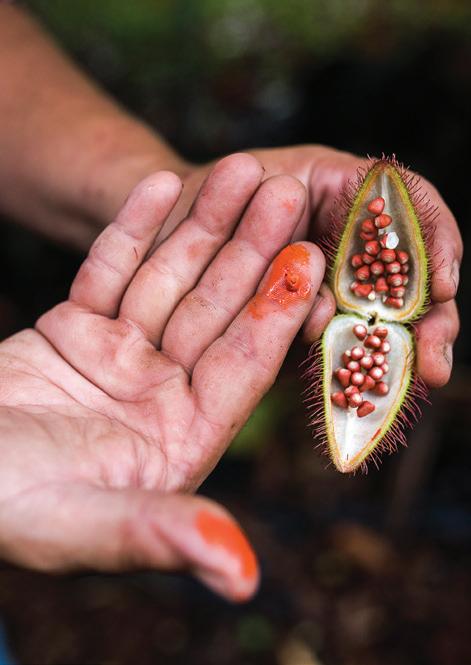

after eating.” By growing nutrient-dense, locally grown food through sustainable techniques, they hoped to encourage better physical and mental health among local families, especially Native Hawaiian and Pacific Islanders affected by chronic disease, and spark cultural connection and entrepreneurship in the process.
But, it would take a laborious grassroots effort to realize their vision. In the four years it took to transform the grounds into arable land, volunteers rem oved 55 tons of rubbish, and recycled and composted much of it. Neighbors offered hauling services, and donated excavator and backhoe equipment. “My friends and I were stripping copper in the bushes,” Chung recalls, “that’s how we made our first few h undred dollars to put gas in the machines and purchase large containers to take away what we couldn’t compost.”
With help from community partners and grants, they planted breadfruit trees and taro, and experimented with composting methods. One of the acres became an experimental food forest and fruit germplasm repository, a valuable resource for Hawaii Tropical Fruit Growers to store and study fruit seeds and genetic material. After six years of groundwork, the garden officially opened to the public in 2014.
Then, in 2016, the garden began the Community Composting Project with Hawaii ‘Ulu Producers Cooperative. Unable to find vermicasting systems, a method of using earthworms to process organic waste, in the United States for less than $10,000, Chung replicated a model from India that cost $500 to build. The 40-by-4-feet bin is populated with Indian blue worms working around the clock to turn thousands of pounds of food and paper waste into organic fertilizer with no effluent or air
Mā‘ona Community Garden offers family and individual garden plots, growing and composting workshops, food plant giveaways and volunteer workdays.
66 | FLUXHAWAII.COM
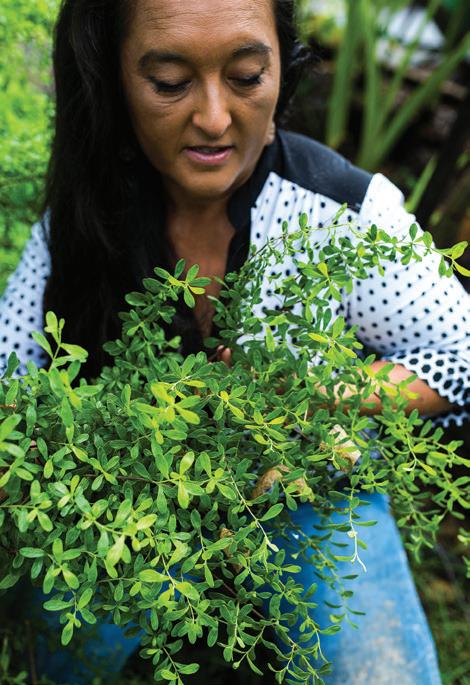
FLUXHAWAII.COM | 67

pollution. “These worms have great power,” Chung says. “They eat waste products and output gold!” Sprinkling a single cup of the vermicast around the base of a fruit tree will inoculate the soil around the tree’s entirety. The composting project has been so successful, the garden is now able to offer its worm-made fertilizer to schools and organizations free of charge, and to farmers and gardeners by donation.
In 2021, the garden completed an expanded aquaponics system, comprising four grow areas inside a 3,500-gallon tank. Thanks to the off-grid water catchment and a solar-powered ebb-and-flow pump setup, the closed loop system sustains plants and fish using less water and space than traditional soil gardening techniques. Food plants such as watercress and ong choi thrive next to swimming guppies, which will soon be replaced by awa, ‘ama‘ama, and other fish traditionally farmed by Native Hawaiians.
Currently, Mā‘ona Community Garden offers family and individual
garden plots, growing and composting workshops, food plant giveaways and volunteer workdays. They host a monthly Community Cardboard Shredding Day, where residents can bring in their boxes or pick up freshly shredded cardboard to feed their compost. Plans for expansion include adding two additional worm bins, upgrading the solar electrical system, and building a certified kitchen with attached farmers market, expected to break ground in late 2022.
A goal is to eventually get the community garden’s composting and aquaponics models to turn a profit and create living wage jobs. Chung hopes to empower Hawai‘i residents to create their own sustainable, economically viable solutions to environmental and social challenges. “The idea is to get the template of problem solving out there,” she says. “We want to give people permission to look around at their community and ask, ‘How can we do better with what we have?’ Because no one is more powerful than you and I.”
In 2016, the garden began the Community Composting Project with Hawaii ‘Ulu Producers Cooperative.
Follow Mā‘ona Community Garden on Instagram at @maonacommunity.
68 | FLUXHAWAII.COM


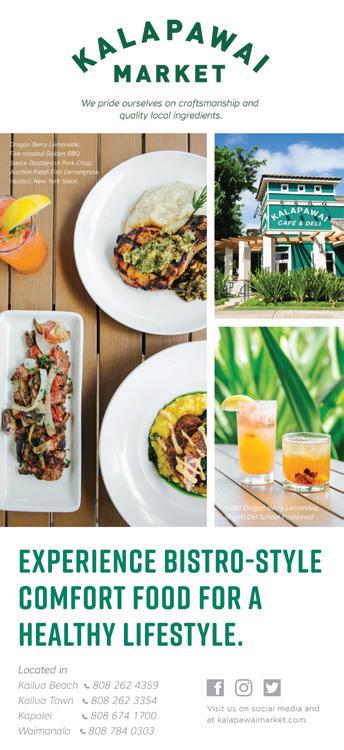
WATCH NOW ONLINE NMGnetwork.com/FLUXTV
 ‘Ohe kāpala, or bamboo stamps, are used in stamping kapa. Image courtesy of Lehuauakea.
‘Ohe kāpala, or bamboo stamps, are used in stamping kapa. Image courtesy of Lehuauakea.
FEATURES
“I was in love with the word ‘aloha’ … which is getting so hard to say.”—Eric Chock

A Written Movement
After nearly 45 years, Bamboo Ridge Press continues to nurture Hawai‘i writers and preserve their words. Its first issue is a story in and of itself.
TEXT BY KYLIE YAMAUCHI
ARTWORK BY MITCHELL FONG
FEATURE 72 | FLUXHAWAII.COM
FLUX

Iwas in love with the word ‘aloha’ … which is getting so hard to say,” Eric Chock pens in “Poem for George Helm: Aloha Week 1980.” In this elegy, Chock mourns the late Native Hawaiian activist and singer, who disappeared at sea in 1977 while protesting the military bombing of Kaho‘olawe. The local Chinese-Japanese poet conjures a nightmarish yet recognizable image of Hawai‘i: malihini who swarm the islands, commodified expressions of aloha at every turn, an occupied nation plundered of its culture and land. Helm flickers in and out of Chock’s prose — ghostlike, silent, and irredeemable. “There is no chance of seeing him walk up to the stage / pick up his guitar and smile the word at you across the room,” Chock bewails.
Local literature like “Poem for George Helm” depicts a real Hawai‘i — narratives that are typically censored by travel brochures and magazines, unseen by ingenuous tourists, and yet realer than ever. As playwright Darrell H.Y. Lum wrote, “This isn’t standing-in-awe-of or ain’t-it-beautiful nature writing that we’re talking about. It’s chemicals in the milk and water, it’s not washing the car or watering the lawn when there’s a water shortage; it’s volcanic ash in the air from an eruption two islands away or the sky gray with ash from burning sugar cane.” This is the Hawai‘i that he and Chock know from experience. Generations of writers before knew a Hawai‘i bound by colonialism, grown in the plantation fields, and stricken by war. Local literature uncovers every palimpsest of Hawai‘i, no matter how harsh or how beautiful.
Yet prior to the 1970s, Hawai‘i’s local literature was stigmatized and largely went unpublished. Whereas on the continent, an Asian American literary movement was blossoming, sparked by the incendiary words of Frank Chin, Jeffery Paul Chan, Lawson Fusao Inada, and Shawn Wong, the editors of Aiiieeeee!: An Anthology of Asian-American Writers published in 1974. Inspired by the Black Power and Chicano movements of the ’60s, this new movement complicated Asian American
identity and distinguished it from the immigrant identity of their ancestors. “I had the conscious idea that literature of different kinds was essential to different social movements,” Chock recounts. With this as their compass, he and Lum would establish a Hawai‘i-centered literary press, Bamboo Ridge Press, and galvanize a local literary awakening.
Today, the University of Hawai‘i at Mānoa’s English department boasts a variety of courses in Hawaiian and Pacific literatures and a faculty stacked with kama‘āina professors. But in 1973, when Chock was a first-year graduate student, the department was strikingly haole. The curriculum eschewed local narratives and local leadership in classrooms in favor of the literary “canon” and transplant professors. The sole Pacific Literature course centered on European stories of the Pacific, like those written by Mark Twain, Robert Louis Stevenson, and Jack London. Such stories, as we know today, perpetuate harmful stereotypes about Hawai‘i, particularly natives, as infantile, idyllic, and savage. Ironically, these were the ideas being taught to local students about their own communities.
The English department of Chock’s time also hosted a visiting writers program which, at first glance, was impressive. Notable American writers such as Allen Ginsberg, Margaret Atwood, and Adrienne Rich led workshops and gave talks to students. But an ignorance of local culture created an undeniable gap between the mentors and students. (According to Chock, one visiting writer urged students to dedicate themselves to European texts.) Meanwhile, at Hawai‘i Board of Education meetings, some residents petitioned against speaking Pidgin in public schools.
Erasing Pidgin, formally known as Hawaiian Pidgin English, would mean cutting out the shared tongue of Hawai‘i’s diverse population and erasing a part of history. We, locals, know the story well because our ancestors lived it. When thousands of Japanese, Chinese, Korean,
The idea to start Bamboo Ridge Press materialized on porch steps one evening in 1977 over beers and card games.
“We realized that theories about literature need to be supported by a critical substructure of scholars, who would write reviews and actual analyses of the work that would bear out some of the theories or contradict them,” Chock explains.
74 | FLUXHAWAII.COM
“

Portuguese, and Filipino immigrants flocked to Hawai‘i to work on the profitable sugarcane plantations, a dialect was born. Despite being segregated by plantation rules, immigrant and Hawaiian workers sought to communicate, picking up certain words and phrases from each other’s homelands, eventually forming a dialect that crossed racial lines. Like any language or dialect, Pidgin evolved with each new generation and has become a defining trait of local culture and identity. Yet some residents in Hawai‘i viewed Pidgin, compared to the aspirationally “posh” English language, as atavistic and, thus, detrimental to Hawai‘i’s youth.
“In all these factors, the main underlying point is that we in Hawai‘i are expected to believe that we are subordinate to the Mainland,” Chock posited in 1980 at the Writers of Hawai‘i Conference. “At best, we are expected to believe that we are really no different here and can even be like the mainland if we try hard enough. We are asked to reject the feeling that Hawai‘i is special.”
But as anyone who has lived here has come to know, Hawai‘i is distinct in numerous cultural ways from the continent, not to mention isn’t legally a part of the United States. One only has to read Muriel M. Ah Sing Hughes’s poem “Bebe You Can Be” to understand (or not understand). In one stanza, the poem’s speaker, a mother, urges her daughter, “Be da Grace Kelly you wen see at da movies / So what if you get daikon legs, and lolo Jacob call you spastic / You can always look pretty, and dance good cuz ‘as Hollywood.’” Hughes’s Pidgin rolls off the tongue sweet like li hing mui and savory in its delivery. She doesn’t explain to malihini readers what “daikon” is or what “lolo” means, nor will I attempt to. Every line is an inside reference, with minor Western influences scattered throughout, whether it be Grace Kelly or Evening in Paris perfume. There’s a certain
satisfaction that comes with such poems — in being able to perfectly understand and fluidly recite words that a continental reader would stumble over. The “broken” English feels no longer broken.
Clearly, then, the issue wasn’t that local narratives didn’t exist. It was that local narratives weren’t being included in classrooms or the published page. (Little to no poetry by an Asian writer from Hawai‘i was published from the mid-1930s to mid-’60s.) Local narratives, real and fictitious, manifested predominately in “talk story”—casual conversations told around fishing poles and in the surf lineup, over the dinner table and atop futons, at recess and while in line for Foodland’s poke bar. For Native Hawaiians, these oral narratives are also called mo‘olelo and it can range from an inherited story about one’s genealogy to a supernatural legend of deities. Framed by tradition and spirituality and tinged by the traumas of colonialism, the Native Hawaiian literary tradition of the 21st century underwent its own revival in the late ’60s and ’70s, a period known as the Second Hawaiian Renaissance. Following in the wake of his influential essay “On Being Hawaiian” in 1964, hapa Hawaiian writer John Dominis Holt IV published short story collections and fiction, including his 1976 novel Waimea Summer. Meanwhile, Wayne Kaumuali‘i Westlake experimented with Hawaiian, Western, and Eastern forms in his poetry, reflective of his mixed heritage. Along with both writers participating in local literary circles, Native Hawaiian mele, oli, and mo‘olelo significantly influenced the way local narratives were composed.
In a community abundant with stories, Chock had to dismantle classroom walls to allow for more representation in literature, which was no easy feat. In his first-year of graduate school, he was hired as Hawai‘i’s coordinator for Poets in
the Schools, a national initiative to introduce public school students to poetry writing through visiting poets. He taught students and teachers about the importance of local literature, referencing works by friends and peers, which at the time only existed as drafts or mimeographs.
His colleague, Cathy Song, whose 1983 collection Picture Bride would join the canon of Asian American literature, used crisp and quiet language to reflect on her KoreanChinese upbringing in Hawai‘i, paying homage to her parents and ancestors. Meanwhile, Lum inundated his short stories and plays with boisterous, unapologetic Pidgin, which according to Chock, were favorites among public school students. Then there was Wing Tek Lum, the most published Hawai‘i poet in Asian American poetry collections throughout the ‘70s, who ventured beyond his own experiences in Hawai‘i, New York, and Hong Kong to write about the larger Asian diaspora. If nothing else, Chock’s own poetry nostalgically reentered his dreams and childhood, often musing about his beloved father, as well as fishing. There was no shortage of writers that he could invite into the classroom.
Although Poets in the Schools created a milestone for local literature, there was yet to be tangible trophies of progress, in other words—published books. “We [Darrell and I] realized that theories about literature need to be supported by a critical substructure of scholars, who would write reviews and actual analyses of the work that would bear out some of the theories or contradict them,” Chock explains. In other words, local literature lacked “legitimacy” within the publishing world. However superficial such a status may be, it would necessitate local literature into the hands of university students, professors, book critics, and the larger public. Far from art for art’s sake, local literature contained political and cultural
76 | FLUXHAWAII.COM

importance that needed to be discussed.
The idea to start Bamboo Ridge Press materialized on porch steps one evening in 1977 over beers and card games. Old grade school friends turned writing colleagues, Chock and Darrell were eager to start a literary magazine, one run by local editors who valued local subjects and voices. “If you owe any allegiance to your culture, it’s usually going to appear in your writing,” Chock tells me over the phone. “There is going to be some conveyance of values that you learned.” At the time of the press’s founding, when so little was being taught in schools about ethnic cultures and harmful stereotypes dominated the media, it was important that ethnic literature accurately portray its respective cultures. Ethnic literature then, as it still is today, was a way for underrepresented groups to change the narrative, literally, and tell their own stories. When these books entered classrooms, they often stood for entire racial groups and were read with an intent to teach.
For these reasons, Chock and Darrell distinguished Bamboo Ridge as a press for and about Hawai‘i’s people. Even the press’ name, taken from the local fishing spot near Hālona point, hinted at the exclusive quality about the press. It maintained a “local’s only” aura, and really, who could blame them.
Bamboo Ridge’s first issue was released in December 1978, under the theme New Moon. For a grassroots project, the journal exuded professionalism with its formal type, organized layout, and binding. A former art major, Darrell provided the cover art for the first issue: a scratchy drawing of the namesake fishing spot, a handful of poles seen jutting out from the rocks, a shack for lounging fishermen tucked into the cliff’s face. Sixteen authors, all recruited by the editors from former classes or writing circles, filled the 46 pages of the journal with mesmerizing short stories and poems wherein each author grappled with their
own identity and relationship to Hawai‘i. Like the slivering outline of a new moon, there wasn’t much more to see of the press yet, but over time it would grow, along with its contributors and influence. “To me, becoming a periodical was their commitment to a disciplined future,” wrote Wing Tek, an early supporter of the press and Bamboo Ridge’s current business manager, “a formal promise that there was more to come.”
In October 2021, Bamboo Ridge released issue 119, entitled Kīpuka: Finding Refuge in Times of Change. A new batch of editors don the glossy cover and more than 40 creatives offer their voices across crisp, white pages. As its name suggests, Kīpuka offered a reflective and resting space for local writers to respond to the turbulent events of the past two years, which not only devastated Hawai‘i but the entire world. The stories and poems need not address Covid-19, or Black Lives Matter, or Maunakea, but simply say what they want to say. To create anything during this time was in itself a victory.
A captivating eight-part poem by Mahealani Perez Wendt titled “Na Wai Ea, The Freed Waters” closes the issue. Like an oli, Wendt eschews excess punctuation, her words flowing and unceasing like the wai which runs through the lo‘i fields that open the poem. Scattered throughout like wispy waves, italicized Hawaiian words and phrases effortlessly blend with her English. She takes readers through the lo‘i’s “green hearts /…laid bare under rains,” past “hidden places / where the high waters fall / in rainbowed silence,” and into ka‘ao where “the gods Kāne and Kanaloa / refreshed themselves in springs / near groves of red and yellow lehua.” And after completing this fulfilling journey through Wendt’s words, an endnote from the editors remains. “At the author’s request, certain Hawaiian words have been italicized because to her, they are beautiful and special.”
There’s a certain satisfaction that comes with being able to perfectly understand and fluidly recite words that a continental reader would stumble over.
Far from art for art’s sake, local literature contained political and cultural importance that needed to be discussed.
78 | FLUXHAWAII.COM

Creators of Kapa
The artists Nanea Lum and Lehuauakea discuss kapa making, colonial institutions, and the hard-bitten truths of being a contemporary Kanaka Maoli artist.
IMAGES BY KARA AKIYAMA & COURTESY OF LEHUAUAKEA
FLUX FEATURE 80 | FLUXHAWAII.COM

The Western concept of art is not really translatable into the Hawaiian ideal or identity,” says the kapa artist Nanea Lum. She appears as a floating head in my computer monitor. Next to her on screen, Lehuauakea, a contemporary of Lum, nods emphatically within their own virtual square on Zoom.
The two are thousands of miles apart—Lehuauakea resides in Oregon, Nanea lives in Hawai‘i. Yet, as Kānaka artists, their paths are constantly converging. At present, the topic: breaking down the differences between Western versus Native Hawaiian notions of artmaking. While the subject reads didactic, their firsthand experiences ground it in something urgent. Their discussions often straddle this line, pedagogical themes steeped in real-world relevance.
Their art, too, straddles binaries: traditional practices worked within modern-day contexts; contemporary narratives told through multigenerational stories; and reexamining institutions while existing within them. It is a liminal space within which Indigenous artists often find themselves, particularly as they work through the artworld. Here, Lehuauakea and Nanea discuss the complexities, dualities, and realities of being a contemporary Kanaka artist today.—Eunica Escalante
NANEA LUM In Hawai‘i, as a Hawaiian artist, I’m still having to support myself by working night time jobs just to pay my everyday bills or even to start paying back my student loan.
The unfortunate circumstance in Hawai‘i is that Hawaiian fine artists are largely unsupported by industry benefactors, creating an inauthentic market for art here. The creative industry in Hawai‘i is bottom-line limited; increasing the value of your work is limited to who is made aware of its importance.
As much work as I do as an artist in the community, working for a nonprofit like the Hawai‘i Arts Alliance or as a teacher, it’s still not enough to give me consistency and security. So, I have to put myself in the line of fire during this pandemic. I have to go to work every night and talk to tourists—be a “good person” of this place by hosting others.
I’m not going to lie, sometimes I think about where you’re at in Portland, Oregon, where there is an Indigenous community with more support for the arts. Diaspora is still a state of being Hawaiian, one that so many of us have to navigate. I really admire the way that you’ve stood your ground as a Hawaiian artist, but getting to be with other, more supportive communities.
LEHUAUAKEA It’s been a lifeline for me. It’s not just Native Hawaiian support up here. It’s not even just Pasifika support. It’s an Indigenous community as a

whole that has really floated me the whole time that I’ve been up here, especially during the pandemic.
I was talking to my grandma the other day, and she was giving me a hard time for not moving back—she was just joking because, you know, grandmas. I told her that I’ve been trying to move back ever since I graduated college. That was the plan. But then work kept coming in for me here, opportunities for my career and what I had gone to school for—which is not always the case for everyone, especially in the arts.
It makes it more complicated to have roots in so many places. My heart and my spirit is back home on the Hāmākua coast. And my financial security is here, in this completely different place that’s over 2,000 miles away. Eventually, I do want to move back. But it’s all contingent on my financial security, when it’s feasible.
Diaspora, it is what it is. It doesn’t make you any less Kanaka or Indigenous. It just means that you’re being those embodiments of your identity somewhere else.
82 | FLUXHAWAII.COM
A kapa piece by Lehuauakea, pictured opposite, image by Moriel O’Connor. Opener, image of a detail on “O Haumea Kino Pāha‘oha‘o” by the artist.
“
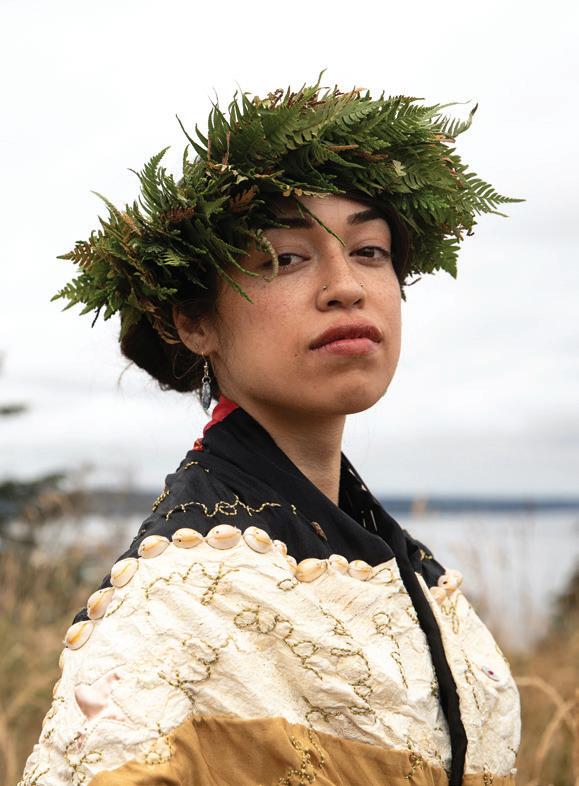
I think that’s the story for an increasing number of us these days. A huge reason I do what I do is to encourage people like me, who have split stories, to keep going and to connect in whatever ways that they can.
If I can provide that connection, through workshops or showing my work and creating spaces for other people to do the same, that’s how I can contribute. But it hasn’t always been easy for me. There are tons of times where I felt lesser than, you know?
NL Yeah, and I think that’s the kind of consumerism we are all living through now, right? The discourse of our art goes onto an online market for consumers, they either want it and need it right away, or they just say, “That’s nice,” and keep scrolling. This discussion we’re having about contemporary art is about guiding people towards how they can spend more time looking at Hawaiian contemporary art rather than just being like, “Oh, can I consume it? Can I go to Hawai‘i, put it in my portfolio of life experiences, and then just go back home?” Sometimes people want things so immediately. Really, we’re cultural leaders as contemporary Hawaiian artists. We’re looking at philosophy and culture and how those things inspire us to keep innovating.
As I have been coordinating the Grric Contemporary Gallery at the University of Hawai‘i at Mānoa, I’ve collected perspectives about this contemporary art market from the artists themselves on contemporary art in Hawai‘i, which is very different from contemporary Hawaiian art. I’m asking questions like, “How do you describe your creativity? How is our Hawaiian art a part of ‘āina? How does it fit into the context of aloha ‘āina?”
All of their answers explained that Aloha ‘Āina is the resistance from inside all of us—to keep expressing our vitality, loving our life, water, and land despite its improper use and it being illegally occupied by the federal government of the United States. We’re all just being forced into the machine, right? But there’s still these people who live resistance and who breathe new meaning into our ‘Ōlelo Hawai‘i.
“E Pi’i Ana O Lalo” by Nanea Lum is canvas with buried canvas, Waiakeakua stream bed, and ‘alaea earth pigments with rabbit skin glue. Overleaf, portrait of Lum, image by Kara Akiyama.

84 | FLUXHAWAII.COM
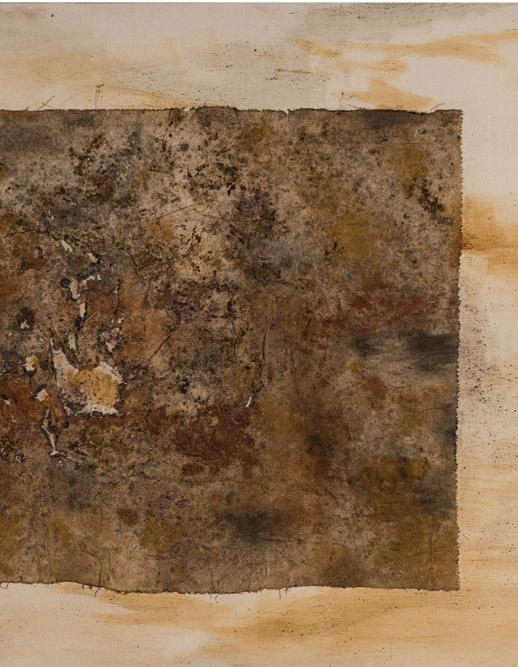
FLUXHAWAII.COM | 85
I mean, kapa work, right? Being a kapa artist, you’re really using the symbols of old and the language that the materials give us to be in context with our kūpuna long past.
L I was talking to Uncle Tom, who you probably follow: @homaikapono on Instagram?
NL Yes!
L Super cool uncle, super ‘olu‘olu vibes. But he asked me to be a part of this hui for the next year, focusing on mahina cycles and situating yourself within time and place according to what’s in the sky. He was talking specifically about kapa makers, who he believes are critical to the revival and reclamation and resilience of the Hawaiian people.
Kapa making includes one of those non-mediated rhythms, similar to kākau. That tap, tap, tap, tap. It’s one of those ancestral rhythms that still flows unmediated from thousands of years ago. And not only that, it’s also a flow in the rhythms of ‘āina, of the mahina cycles, and how to do that work within a certain context of place and time.
I never really thought about it like that. Kapa makers are so important. We are, like you said, in touch with putting ourselves in the company of our kūpuna, their form of communication and telling stories. But we’re also creating new stories and new ways to tell those stories using new patterns, new ways of working with this material.
Then, I think about the others who are part of this growing force of resistance and resilience. It’s not just kapa makers. There are other artists, activists, and community members. There’s not just one textbook way of engaging. We need that diversity in our approach because that’s the resilience. It’s that varied approach that creates a strength between everyone who is involved.
NL Exactly, those are the discussions that need a longer look. I’ve asked other creators too—those who refuse the title of artist because it denotes too much societal privilege—how can art made by a Hawaiian person transcend Aloha ‘Āina. And their answers really draw back to those two realms that you just spoke about. Some people talk specifically about getting into the wā, that unmediated rhythm. Their art is really tapping into that Hawaiian methodology, a heritage of aesthetic that considers the wā ma mua, the time before us. This way of knowing the world comes from a familial relationship to ‘āina. Retelling the nature of this relationship is what being a Hawaiian artist is
about: being able to work towards a hana no‘eau.
Then there’s also, like you said, those mahi‘ai people who are influenced by living resistance. These aloha ‘āina activists use a different Hawaiian methodology: a responsibility of building and protecting relationships, to repair the past, and to see into the future. These artists activate earth, and display knowledge coming from their experience of the ‘āina.
I guess what I’m doing from my critical lens as a Hawaiian artist is to make it explicit that those people are still contemporary artists like I am. Even though they’re only carrying pōhaku to rebuild our fish ponds, I really see them as an artist because of the wā that they tap into in order to create. Like us, they really understand how to process material. Their work is still a kind of art even in this contemporary time.
There are all of these examples through time and history that tell us what art is. We in Hawai‘i don’t have that same history for our people to tell us what our version of contemporary art is.
L You bring up a good point because the word artist is not our word. We never really had a word that directly translates to the English “artist.”
NL “ Hana no‘eau. ” That was one answer from Nālamakūikapō Ahsing. He says that the Western concept of art is not really translatable into the Hawaiian ideal or identity. Instead, we think of our creation as t hese hana no‘eau: methods that teach lessons, define talents or instill a knowledge pathway.
L That’s good. For me, that’s the closest translation or bridge-crossing term that I can think of: creation or creative. It speaks more towards the Hawaiian understanding of where all this is coming from. It becomes shallow when you think of it in a Western art context. But, for a lot of, if not most, Hawaiian artists nowadays, creation can mean tapping into something deeper.
It’s the creation of Pele, the force behind her energy to create entirely new land masses. Or the power of creation held within a seed versus just taking a brush and splattering some paint on a canvas. They both have elements of creativity, but one is rooted in something deeper, something intergenerational and spiritual. And I think that’s what makes a lot of Indigenous art rooted in something that transcends time. That’s where a lot of the power comes from.
86 | FLUXHAWAII.COM
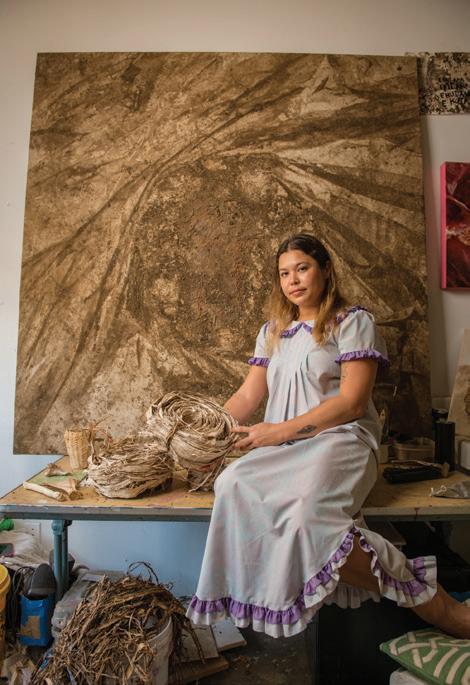
FLUXHAWAII.COM | 87
NL One issue, too, is that Indigenous creation is outside the scope of the Christian concept of creation. And so most audiences come with a personal baggage towards creation and creativity because they usually view it from a myopic, Western lens rather than something that is truly generative. We both went to art school, and we had to deal with that a lot. People would usually take our stories for granted because not everybody has the same level of deepness to their roots.
I hope that our audiences can start to see the world not just through how they were raised, but through the fact that they can learn from other peoples’ stories.
L A lot of our non-Hawaiian audiences are starting to shift their appreciation for works that are created beyond the context of their own worldview. Just in my experience, there has been more openmindedness for contemporary Native artists and what they’re contributing, what they have historically gone through and how that resilience plays out in the context of their own work.
On the other hand, it’s something that we always have to deal with. At this point in time, we are still treated as the token in a lot of spaces. We’re seen as the other or labeled as “the Native artist”—not just as artists. There’s always going to be that inherent distinctive label put on it.
I’m not necessarily saying that’s always bad. But it does at times put you in a pigeonhole, where you’re expected to deliver some extravagant, often exotic package. Especially being from the islands, viewers often expect a certain level of performative experience from us.
A lot of the work that I’ve been doing lately is saying fuck you to that. Fuck your expectations. Fuck your postcard images of what you expect my ancestral islands and culture to be. This is how I’m showing up now, and you guys need to wake up to that. Part of that for me is not providing translations for the titles of my pieces. I used to, but in the last year or so I’ve stopped. And that goes back to the colonization of Hawai‘i and how our language was stripped away from our families and our kids. We’re only now starting to really get that momentum back.
As a Hawaiian artist it’s deciding what you want to share. Is it going to benefit your community, your family, and you as the creator? Or is it just going to be appropriated instead of appreciated? Doing this kind of work you walk a really narrow line straddling these two fields.
NL That’s really great that the museum structure can appreciate your work and start to show it to an
audience whose worldview you can really influence. In 2021, you came and saw my thesis show Eia Ke Kumu. There was no kapa on the walls, but kapa being made in the room. And that was my insistence because a lot of our institutions, like museums, will take kapa made by contemporary makers but appreciate it only as an Indigenous story. Yet, we know that there’s more to the work than just the final piece.
My kumu Verna Takashima, she makes kapa so rigorously and at such scale. She lives in Papakōlea. She inhabits these very spiritual places, and all of that is connected to her art practice completely. Yet the museums and institutions here are still only interested in the final product, in the kapa moe itself. Which is cool, we need our kapa moe to be shown in museums, especially as a representation of Hawaiian culture. But there should be more focus on our makers and the process of making because that is going to help bridge the gap between appropriation and appreciation. You can look at a finished kapa and marvel at how wonderful it is. But if you haven’t seen the hard labor that went into making it, then you might not fully understand how special it is. So, I’ve been making a lot of videos and installing them in galleries or physically going to galleries to make sounds with my tools. I’ve begun beating kapa there so that that the audience can understand that this is not just about the finished projects. This is about living our resistance, making and tapping into the wā as often as we can.
L It’s like looking at the tip of the iceberg without seeing the huge, massive resistance that lies underneath the surface. That’s language reclamation. That’s land reclamation. That’s understanding the roles and the cycles of the plants that we use for the dye, the beating.
NL The water.
L Totally, which is a huge issue for native people right now, not just Kānaka. As artists, it’s in our nature to recognize these things because we’re in it. We’re in the process, we cannot make kapa by just doing one part. You have got to commit to the whole thing. And once you start doing one part, you realize, “Oh, I got six other parts I’ve got to learn.” And the journey never stops.
It’s not going to happen in one generation. We’re undoing generations of these systemic obstacles that were established by foreigners to keep us down, to force us to assimilate, to claim that we’re not beneficial to ourselves or our culture or our ‘āina.
88 | FLUXHAWAII.COM

FLUXHAWAII.COM | 89
Detail of “Nā Kinolau”
And whether we’re doing that back home or for our diasporic communities abroad, I think that still carries just the same amount of weight.
NL That’s beautifully said. We’re really making sure that the next generation doesn’t have all the same obstacles as us because we did the work to free up the language. That was what my whole thesis was about, freeing up the language.
But also in these spaces, we need to make room for unapologetic Hawaiians like you who don’t need to translate. They are speaking to their audience. They’re speaking to their hoa ‘āina. Why should there be translations involved here?
L Yeah, I think it’s important to for us to be unapologetic. We’ve been born into this culture that really was trained to cater to haole or to foreigners, to make our culture palatable to them, to make it sellable. If we’re too-this or too-that, we feel the need to apologize or to tone it down. Where I’m at in my work and in my own personal growth as an individual, I’m just like, enough already. We’ve spent our whole lives being that way. And not just us—our kūpuna and their kūpuna too—everyone was toning it down to make other people comfortable.
NL Or were they being clever? The act of subversion and of being subversive is a concept that often feels elusive to me, but I think it is so important. On one hand, you can try to erase the meaning of an artist’s work. But on the other hand, they’re going to keep creating and subverting the white dominance of everything.
At the end of the day, if our hoa ‘āina are the only ones who understand us, then we won. We did exactly what we were trying to do. Our art is not for the masses. It is for awakening of our Indigenous community and for decolonization. Our people have all met us at that mana and we continue to create.
L Yes, real mana recognizes real mana. If people cannot understand our art—if they cannot hold a tree and feel water—then they haven’t done the work yet. And that doesn’t mean that they’re not going to, but that they have not been immersed in the kind of mana that it takes to recognize that deeper relationship. It is about decolonizing our relationships to ourselves, to each other, to all the things that go into whatever it is we’re doing. And it goes back to the importance of finding solidarity with other Native
people who are not just from our community, not just from Pacific Islander labels, but Indigenous people as a whole. We’re all very different, but there’s a lot of similarities between our cultures.
It makes the work even more powerful. I feel more affirmed and that what I’m doing is bigger than myself. I know that we’re not alone in what we’re doing or what we faced historically. That kind of solidarity expands generations.
NL I’m looking at the photos that we chose for our Zoom backgrounds. It’s really amazing how we both have versions of our kapa behind us. I think discussing them would be the perfect way to close.
The kapa you’re showcasing embodies that material kapa, the symbols and patternology of our kūpuna in order to navigate the surface for yourself. Am I right?
L Yes, exactly.
NL I love that. Now, you go for me. What’s my kapa doing for me?
L To put it simply, your kapa is getting down and dirty with it. It embodies actually, literally going to the roots. And I think that’s super important for kapa makers to know where their trees are coming from and to have access to that. As soon as you put up this photo of your painting, there was this instant recognition. The way you captured the light going through the wauke leaves, it’s spot on.
NL Yes, I’m really using painting to relive all the things that kapa teaches me. Making kapa, it enhances my life in such profound ways that I have to paint what those changes are. There are these moments during the creative process where I think, “This is where I want to stay. Stop time forever and just leave me right here.” Those are the moments that I try to translate so that people can understand why we love making kapa so much.
L And it’s hard to translate with words. In fact, it’s impossible. When I’m getting into the zone and beating, that rhythm is just like my heartbeat. It takes me out of the physical form. It stops time. Ultimately, that carries into the finished piece itself. If people are open to receiving that, they’ll see it.
This conversation has been edited for length and clarity.
90 | FLUXHAWAII.COM

FLUXHAWAII.COM | 91
Image by Garrett Vreeland.
FLUX FEATURE

Sliding Giants
The monstrous waves at Pe‘ahi are not for the faint of heart. But for those who find the courage and strength, a sense of triumph and euphoria follow in their wake.
TEXT BY KAI LENNY
IMAGES COURTESY OF
RIZZOLI
92 | FLUXHAWAII.COM
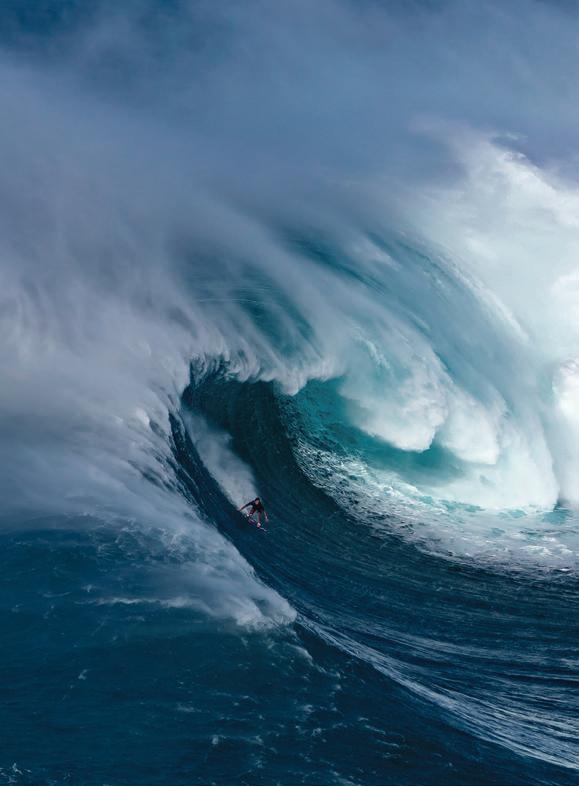
The swell was the biggest-hyped swell in ten years to come to Hawai‘i, and it was scheduled to arrive on the afternoon of January 16, 2021. The buoys were reading twenty-three feet at twenty seconds, meaning that this would be a day to remember and an opportunity to push boundaries. Even though it was right in the middle of a pandemic, people from all over the world were coming to the islands. It was going to be extremely crowded, large, very windy, and with a lot of uncertainty.
That morning, when we arrived at Pe‘ahi, there were well over a hundred Jet Skis, twenty-five boats, and at least ten thousand people on the cliff. We were entering Thunderdome, and Jaws was the arena. As we arrived in the lineup, Shaun Walsh dropped into a seventy-foot wave, and the crowd was just going nuts. I was like, “Oh, my goodness. It’s on.” And it was just getting started—the swell was forecasted to only grow in size and velocity.
At first, my younger brother, Ridge, was uncertain about surfing. “I’ll just tow you; I don’t want the smoke,” he said. Up to this point, Ridge had never fallen out there, or never gotten really pounded. I told him, “Hey, dude, just go get a wave, and after you do, you’re going to feel so much better driving me. You’ll understand the waves better.”
I always joke with Ridge that he’s a closet big-wave surfer. He doesn’t think of himself as one, but he just doesn’t know it yet. I think this was his coming-out day, where he realized he actually was.
So we’re out the back, waiting. It’s not crowded out there, but there’s a lot of people who aren’t normally out there. You have the top guys in the world—Ian Walsh, Shaun Walsh, Billy Kemper, Makua Rothman, and a couple others. But then there’s also these other teams that were just going on any set waves that come through, and the big sets took 45 minutes to arrive.
In big-wave surfing, the etiquette is that you take turns. Whoever’s been waiting longest gets first pick. Whoever’s been waiting second longest gets second pick, and so on. But all of a sudden, I’m being hassled like I’ve never been hassled. It was a tough and disorderly crowd that day, unfortunately.
The set finally came, and we had been waiting on priority for forty-five minutes; I positioned us super deep to ensure no one would try and snake our wave. I was putting Ridge exactly where I wanted him, halfway down the wave behind the peak so that he would have options to go high on the face or drop low fast. Suddenly, a team comes from the channel and turns right around us; they’re trying to take the wave from us. I literally had to put my hand up and tell them to stop, because if they kept going, I would have been trapped on the wave with my brother, risking both of our lives.

From Maui, Hawai‘i, Kai Lenny is one of the most accomplished watermen in the world. Opener, Lenny surfing with Ridge Lenny on Jet Ski, image by Cody Lang. Above, image by Brian Bielmann. Opposite and overleaf, images by John Hook.
The other team pulled back, and I ended up towing Ridge into the biggest wave of his life so far. Everyone wanted the tallest wave that day, because of world record this and world record that. But at the end of this day, when I look at all the photos, I think Ridge got maybe one of the tallest waves.
I was just so stoked for my brother. At the time, I couldn’t even tell how big the wave was because the plumes of spray were going so high, at least a couple hundred feet in the air. I couldn’t see anything as I chased after him behind the wave. A couple days later, we did a rough measurement of the wave and it came out to around seventy to seventy-five feet tall.
That day, my brother and I were connecting. We were doing something that we’d been practicing for our entire lives. It goes all the way back to when we were little kids, and we were inspired by surf videos of our heroes riding giant waves at Jaws. We would take our bike on the street, and we would tow each other in on a skateboard, using a
94 | FLUXHAWAII.COM


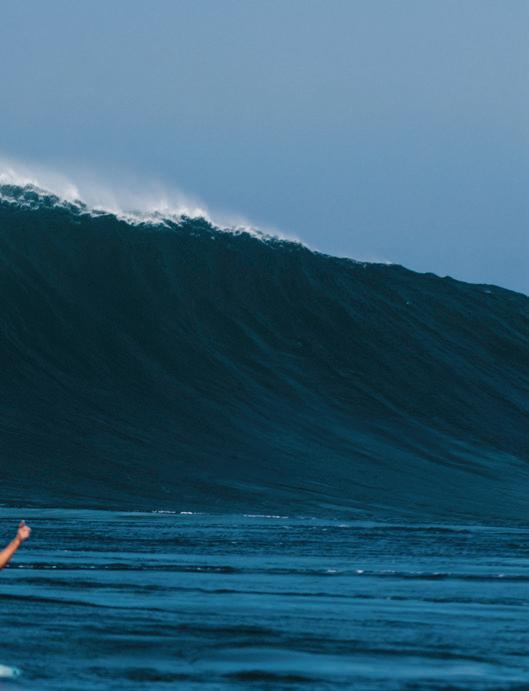
bicycle to whip in down our neighborhood hill. We were imagining we were surfing Jaws—and now we really are.
Once Ridge was done towing, I went out with my safety driver, Ola. After riding a few decent waves, I ended up going on this wave with a windsurfer, actually one of my buddies. We weren’t in sync and it caused me to lose focus and I fell. That was a little frustrating. Ola came in and scooped me up immediately; however, I couldn’t get my board in time and it got taken over the falls. We looped around and chased after the board, but we weren’t able to get within distance to grab it. My friend running rescue, Kolomona, nearly had it before having to let it go to escape the fast-approaching whitewater. I told Ola, “Okay, drop me off on the rocks, and then go out the back. I will paddle it back out.” The whitewater on the inside is probably twenty feet high, and it’s the gnarliest I’ve ever seen it in there. I have to get my board. Somehow, I navigate through it all and retrieve my board stuck between two rocks. I crawl up the rocks, paddle back out, duck-diving through whitewater; I knew if I got swept into the current, I was going to make it out no problem.
“Where’s my Jet Ski? I don’t see my Jet Ski. Oh, no.” I look in, and my Jet Ski is on the rocks. “Not again. This is the second Jet Ski this season, and the third one I’ve ever had at Jaws in the last year and a half.” But in that moment, I can’t panic. I just have to try and save it, and I can’t risk dying in the process, or getting seriously injured like I have in the past. A Jet Ski picks me up and drops me back off onto the rocks. I race to get to my Jet Ski and come to find that somehow the lanyard key for the ignition switch is gone.
I figured I would use my thumb and pointer finger to pull the little toggle up so that it would allow the engine to turn on. At this point, I’m basically teetertottering on one big rock with these twenty-foot waves breaking on the shore. A huge set comes in and picks up the Jet Ski, and in that moment, I pull the toggle with my fingers and I press start. The Jet Ski drives forward and I launch it off of the rocks. I thought to myself, “I’m going to make it.” But then this fifteen-foot closeout breaks in front of me. I go to turn, but the steering is broken. I’m going straight at it. “I am screwed right now. What am I going to do?” I jump and dive through the wave, and my Jet Ski goes back over the falls and onto the rocks. I swim back up onto the rocks and hop back onto the Jet Ski. Back to where we started, and now Ola and Shaun Lopez have arrived to help.
I could see giant waves exploding out the back; eventually that whitewater makes it to us. It is so big, it picks us all up and it takes us over this rocky knoll, probably fifteen feet high. Ola gets stuck under the Jet Ski, which slides over him, pinning him to the rocks, and
Shaun is hanging off the sled on the back. The three of us, plus the Jet Ski, end up in the river and swept into the jungle. While this was unfolding, all these spectators were watching me getting just absolutely pummeled on these rocks. Cameras are out. I’m like, “Wow, this is embarrassing.” But at the same time, it didn’t affect me because I have to deal with what’s going on in this moment here. Fortunately, a couple of bystanders run down and help us hold the Jet Ski and keep it in one place while Ola, Shaun, and I figure out what to do next.
We radio to our team on the boat to update them on our status. They radio the helicopter to see about a possible extraction off the rocks. The problem was there were way too many bystanders around to safely pick up the Jet Ski. So we did the next best thing: we picked up the Jet Ski, all eight of us, carrying it towards the base of the cliff. We end up hiding it behind a tree, knowing we’ll have to come back in two days when the swell comes down to airlift it out of there.
“Are the gods punishing me?” I looked up to the sky and thought to myself. “Or is this a test?” Then I get the strongest gut feeling, the most certain feeling I’ve had maybe ever. I thought, “The gods are testing me right now. This is a test that I need to overcome.” I looked at my Jet Ski driver. I’m like, “You good?” I looked at Shaun Lopez, who was there helping us. I’m like, “Are you okay? Okay. Let’s swim off the rocks right now through this twenty-foot shorebreak on dry rock, and let’s go ride some eighty-foot waves.” And they all agreed.
So we walked to the edge. We’re up in the bushes and waves are exploding. There’s a moment where the waves subside just enough. We sprint down the rocks. These boulders are rolling basically like bowling balls and we’re running on these rolling rocks. There’s a point where you’re totally committed. If you see a wave and you get scared, you can’t turn around. You would get destroyed, or one of those rocks would roll over your leg. So we basically just dove into the ocean and we swam through these breaking waves. A Jet Ski picks up Shaun first, because he’s farthest out, and Ola and I are swimming. I’m like, “We just got to get to the current.” Once we get into the current, we’ll get sucked out, and the Jet Ski will pick us up. I do one last look-back and I see my Jet Ski in the trees. But I have to cut myself off from that and just leave it there.
I get back to the boat and the waves were just bombing; I had just lost an hour of my time getting destroyed emotionally, physically, and spiritually on the rocks. But then everyone asks me on the boat, “Okay, are you done?” I said, “No. Get me my board. I’m going back out there.” This is where my brother really rises to the occasion. Ridge looks at me and says, “I’ll take you out there. I’m going to get you the best waves I can possibly
98 | FLUXHAWAII.COM
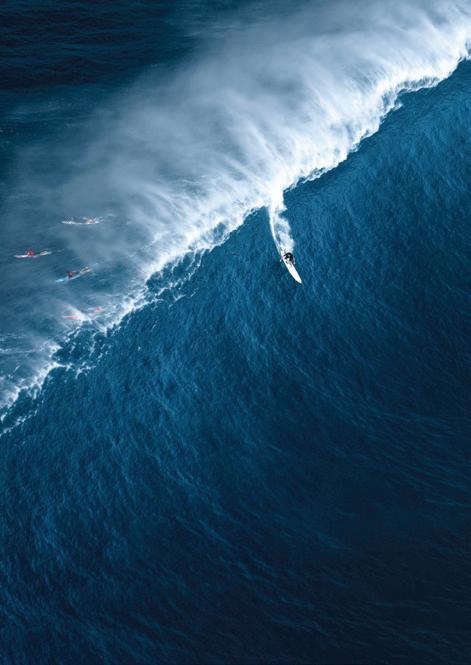
97
Ian Walsh at Pe‘ahi. Image by Shane Grace.

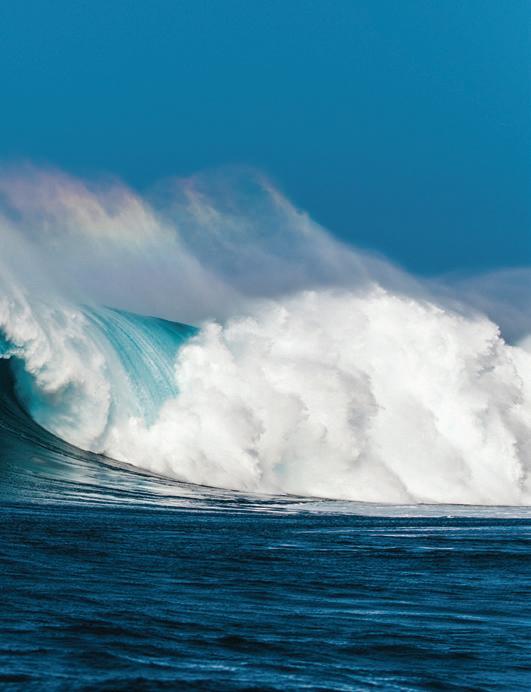
FLUXHAWAII.COM | 101
get you.” And I’m thinking, “This is the moment.” That day, Ridge operated the Jet Ski with more confidence than I’ve ever witnessed from him. He rose to the occasion like no one else.
We have maybe two hours left of sunlight now. “Ridge, let’s just wait for the biggest one.”
A huge set comes. He ends up towing me into this first wave. It was a giant wave, and it was really critical and really unpredictable. I get a long barrel, come out, and I do a big backside 360 kickout. I’m like, “Okay. That was heavy.” I didn’t think it could get heavier, but I knew that it wasn’t the biggest wave that could be caught, because the waves after that wave were gigantic.
Then this monster emerges out of the ocean. It was by far the most western set of the day; it was literally almost coming from the mountains. In that moment, I knew: “This is the test. I have passed all the other tests, but now the gods are going to reward me. And it’s up to me to take this opportunity and get the best ride I’ve ever gotten.” Ridge looked back at me, and I just see his eyes wide. Later Ridge told me, “Kai, your eyes were so wide. It was like you knew what you were getting towed into before you let go of the rope.”
As I let go, my heart sinks. I think I’m too deep. I take a three-second inhale and a three-second exhale just to calm myself, and I do a long bottom-turn. All of a sudden, as I’m bottom-turning, the lip pitches over and it’s by far the biggest—maybe not the deepest barrel I’d ever been in, but the biggest barrel. The lip line, it almost looked like the back of a dragon that was going through the air. It was wafting, curving around the lip, and sucking in like a cannon. I’m watching this lip, and it almost looks like the flames coming out of a dragon’s mouth. I could feel spray hitting my face, but I’m in this cave. It feels like it’s 40 feet in circumference around me.
Then the wave starts slabbing, and it has a kink in the middle. I have to go really high on the wave, and as I drop back in, I’m dropping straight out of the barrel, going over the ledge. I might not
come out…but I do, and then I realize that my ride isn’t over; I still have so much wave left.
I have so much speed, it slingshots me into a top-turn that felt like something I would normally do on an eight-foot wave. The sensation was so great, I try to do something I haven’t tried before: a double backside rotation, a 720. I didn’t make it, and I fell with such incredible speed. It was just an explosion of water, knocking the wind out of me. But at that point I was in the safe zone, and I just saw my brother in the mist emerge. He’s just grinning ear to ear, and his eyes are huge. He says, “I cannot believe you made that. I thought you were gone.”
I hop on the Ski, and it’s sunset. The light is shining through the mountains. I could see my boat and my entire family is there, with all of my friends. They’re just screaming; some of them are crying. And they’re like, “That was the biggest barrel we had ever seen of you, or of anybody. That was the craziest thing.” They were just so stoked. They knew what we had gone through to get to that point. To be rewarded by the universe, the gods, whatever deity you believe in— it was surreal. All of a sudden there was just this tension that just got released in the air. I could really feel it around me—the energy, the ocean, myself.
It just felt like, “Okay, this was one of the hardest days I’ve ever had in big-wave surfing.” It forced my brother to rise to the occasion and become the big-wave surfer we all knew he was. He not only rode a 75-foot wave, but he was able to drive a Jet Ski as good as anyone on the planet, putting me on one of the best waves I’ve ever ridden out there. It was euphoric, and I’ll never forget it. It was a culmination of our entire lives for that special moment.
This article is excerpted from “Big Wave Surfer: The Greatest Rides of Our Lives,” by Kai Lenny, edited by Don Vu with Beau Flemister, published by Rizzoli. Flemister is a longtime contributor to this magazine and author of the novel “In the Seat of Stranger’s Car.”

“Are the gods punishing me?” I looked up to the sky and thought to myself. “Or is this a test?” Then I get the strongest gut feeling, the most certain feeling I’ve had maybe ever.
Lenny is the the youngest person to be inducted into the Surfers’ Hall of Fame. Previous spread and opposite, images by John Hook.
102 | FLUXHAWAII.COM

FLUX FEATURE
Letters to Paradise
If you could send a message back in time to the year 2020, what would you write? Local luminaries offered these handwritten words of comfort and insight to a Hawai‘i at the start of the pandemic.
IMAGES BY JOHN HOOK
104 | FLUXHAWAII.COM
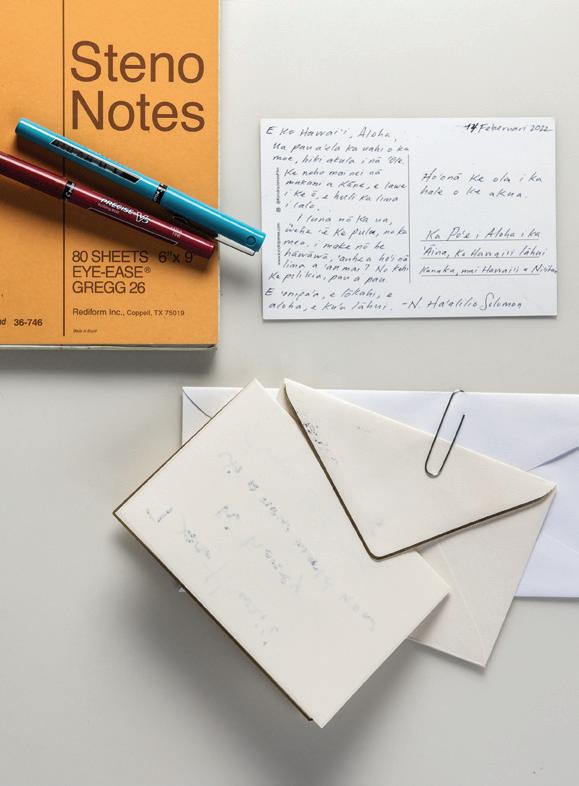

Aloha E Ku‘u Hawai‘i, I’m praying this will HELP. I’d do anything to rewrite fate, to protect you from the HATE and DISDAIN, the DISCORDANCE and PAIN these TWO YEARS yet SUSTAIN, PLEASE accept these words and HEAR MY HEART. Remember ALOHA, EVERYTHING ALOHA, we did it on the MAUNA, we can do it now! We HAVE to, we MUST. Remember hō‘ihi, RESPECT. Respect each other’s decisions. Our differences once made our community rich and unique. Don’t let them TEAR us APART and turn against each other with such ENMITY and LOATHING, even if those differences don’t align with your values and beliefs. It’s perplexing, still, everything is entitled to live as they please. I HOPE you ALL can figure it out, I HOPE in some branch of the multiverse you guys GOT IT RIGHT. Pule, love, and light, Ke aloha nui, Lina
Lina Robins-Tamure is a musician based in Honolulu. She is a member of the Hawaiian band ‘Uhe‘uhene.
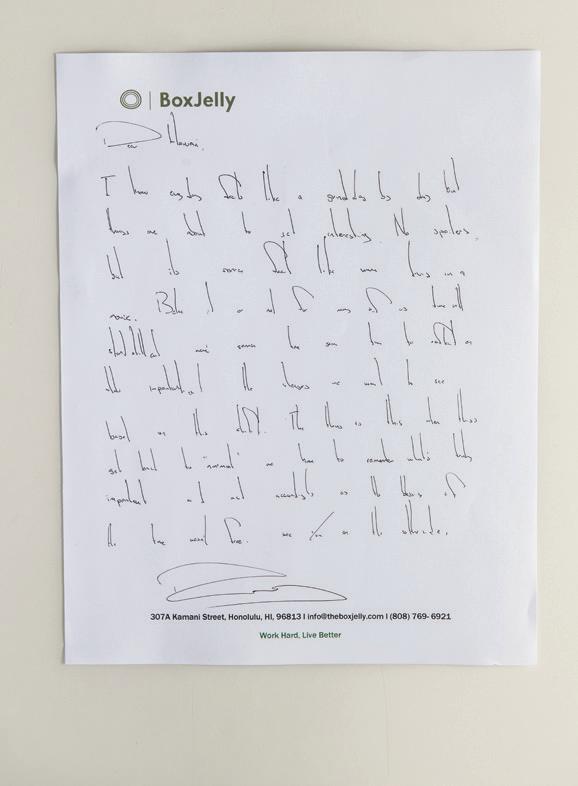
Dear Hawaii, I know everyday feels like Groundhog Day but things are about to get interesting. No spoilers, but it’s gonna feel like we’re living in a movie. Believe it or not for many of us time will stand still. We’re going to have some time to reflect on what’s important, and the changes we want to see based on this shift. The thing is this, when we get back to “normal” we have to remember what’s truly important and act accordingly as the blessing of this time wasn’t free. See you on the other side. Rechung
Rechung Fujihira is the founder of BoxJelly, a co-working space in Honolulu.

Dear Hawaii, A few moments from now, that knee on your back, pinning you down, will be lifted. inhale. exhale. roll your head left to right. shrug your shoulders. release. In your freedom, however brief, your truths will burst forth from your piko and all you’ve ever tried to tell us will be radiant and clear. It will be land, people, aina that feeds. It will be shorelines and ridgelines that will delight our spirits and soothe our souls. At the top of your inhale we sit, in this pause, remembering our way to a knew future. So brief yet timeless this remembering will be we do not need to bow to the feet of the temporaries graveling, calling it aloha. In the radiance of your resilence kipuka emerge as reminders of all that returns after the flow. It is in the embrace of this knowing a knowing that all people, all places possess, that this pause will midwife a beginning to an end. A knew future that marks the ends of dangerous stories of must haves, should haves, need to haves even if its hurting me. The knee will come back down, your head pushed sideways sucking in concrete as you guard your mother mountains but in the pause remember what we already know. Ash
Ashley Lukens is an independent philanthropic and development advisor in Hawai‘i. She is the executive director of the Frost Family Foundation, co-founder of Kūkulu, and co-founder
of Ho‘iwai Fund.

Dear Hawaii, As you descend headlong into the chaos of crisis, I write to implore you: Beware of the Ouroboros—the “tail eater” that survives by devouring itself whole. Gird your hearts and pace yourselves, because the months will drag on into years before any feeling of normalcy returns. Then one day, you will realize you haven’t checked case counts in weeks, and the virus known as Covid-19 will fade into the recesses of your mind. But before then, anxiety. Mandates will come down, walls will go up. Where once the country stood in solidarity against an unknown viral assailant, like the Ouroboros, we will eventually curl inward and gnash our jaws at one another when we realize the only surety we can be certain of is the self. It will become such that we will wish a deadly virus befall both friend and foe—that those unvaccinated and hospitalized had it coming; that those vaccinated, boostered, and infected anyway were wrong all along. We will go through lockdowns and quarantines, then isolate even further by castigating family and friends when their views diverse from our own. It’s easy enough to dismiss someone who irks you and with whom you have an arm’s length relationship, but what about when that person is your best friend, boss, or parent? Most of us are too stubborn, too cowardly, too lazy to consider viewpoints that contrast our own. Why bother when we can wallow so easily in conversation that indulges us? This behavior, while temporarily euphoric, is self-destructive and lonely. It is disorienting to be surrounded by people and to still feel alone, to stand near someone you love but be unable to make eye contact for fear that it might lead to conversation. So, dear Hawaii, dare to look up. You may be surprised to meet a gaze staring steadily back at you. Regards from 2022, Lisa Yamada-Son
Lisa Yamada-Son is the founding editor of Flux Hawaii.
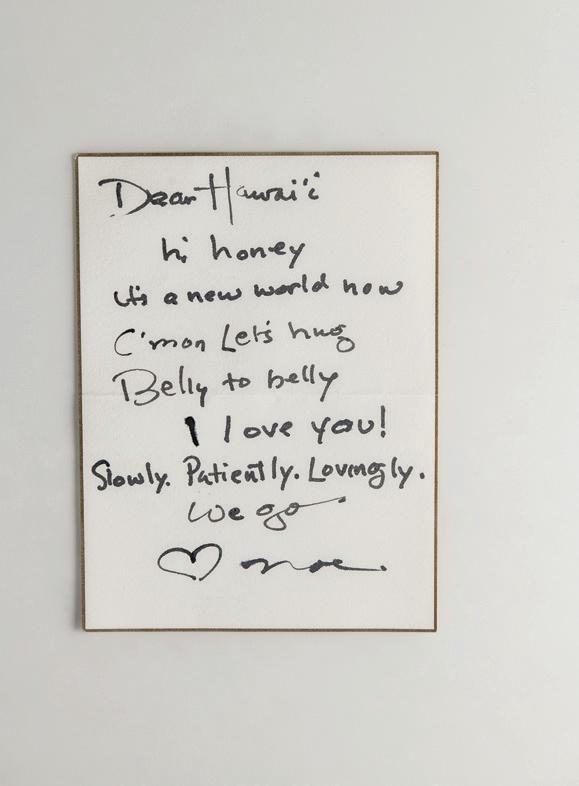
Dear Hawai‘i hi honey It’s a new world now C’mon let’s hug Belly to belly I love you! Slowly. Patiently. Lovingly. We go Noe Noe
is an art, culture, and ideas reporter for Hawai‘i Public Radio.
Tanigawa
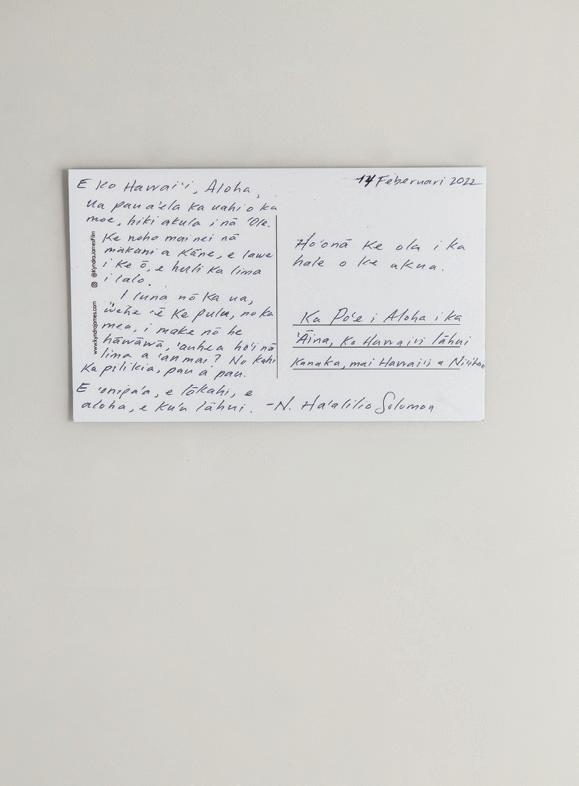
E Ko Hawai‘i, Aloha, Ua pau a‘ela ka uahi o ka moe, hiki akula i nā ‘Ole. Ke noho mai nei nā makani a Kāne, e lawe i ke ō, e huli ka lima i lalo. I luna nō ka ua, wehe ‘ē ke pulu, no ka mea, i make nō he hāwāwā, ‘auhea ho‘i nā lima a ‘au mai? No kahi ka pilikia, pau a pau. E ‘onipa‘a, e lōkahi, e aloha, e ku‘u lāhui. Ho‘onā ke ola i ka hale o ke akua. – N. Ha‘alilio Solomon
He kumu a‘o ‘o N. Ha‘alilio Solomon ma ke Kulanui o Hawai‘i ma Mānoa, a he unuhi ‘ōlelo no Awaiaulu me Ho‘opulapula. ‘O ia ho‘i ka luna ho‘oponopono ‘ōlelo Hawai‘i no Flux Hawaii.
Dear Hawai‘i’s people, greetings of aloha to you all, The trouble about which we were forewarned has arrived, and we find ourselves facing ‘Ole nights of hardship and strife. The winds of Kāne are upon us, so gird yourselves with proper resources and prepare the land. Make these preparations while there is still time, because if one is ill-prepared, how will they survive? When one is distressed, so, too, are we all. Stay focused, be one with each other, show aloha, my people. Life finds relief in the house of the god. – N. Ha‘alilio Solomon
N. Ha‘alilio Solomon is an instructor at University of Hawai‘i at Mānoa and a translator for Awaiaulu and Hoopulapula. He is the Hawaiian language editor for Flux Hawaii.
FLUX FEATURE
This Elusive Light
A reflective look at the islands shines through in the photography of Michelle Mishina.
IMAGES BY MICHELLE MISHINA
112 | FLUXHAWAII.COM


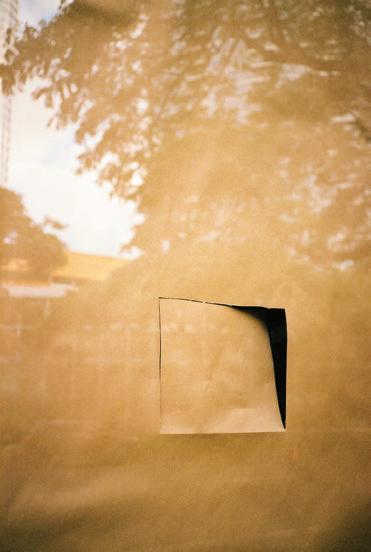







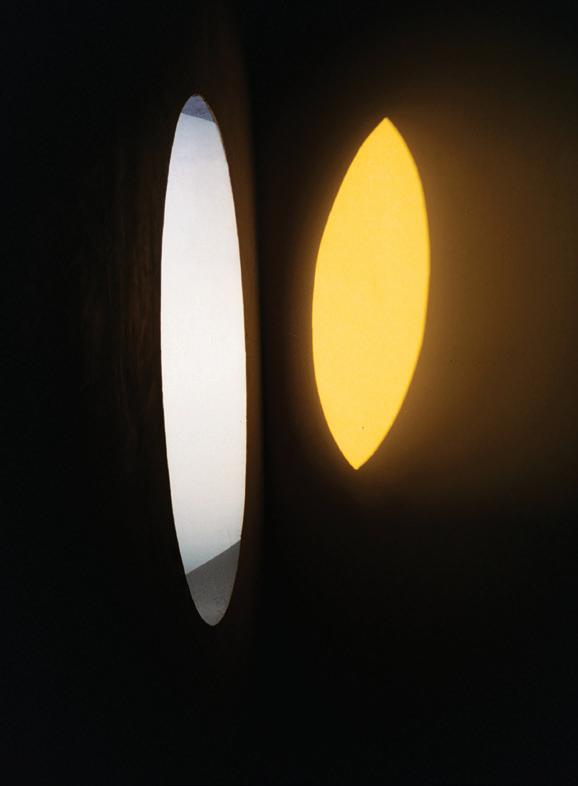
 The interior of EP Bar in Chinatown, O‘ahu. Image by Mark Kushimi.
The interior of EP Bar in Chinatown, O‘ahu. Image by Mark Kushimi.
EXPLORE
“The next time you see a lei or receive a lei, just take that in for a moment.”—Britney Texeira

In a Sentimental Mood
Two new Honolulu businesses pay homage to beloved food and drink experiences with vintage hallmarks at their hearts.
TEXT BY SARAH BURCHARD
IMAGES BY MARK KUSHIMI
I am a San Diego kid, growing up in the 1980s. There is a black crocheted afghan blanket with neon flowers hanging over the back of our living room couch. I’m sitting on the floor flipping through my mom’s record collection listening to the Bee Gees and the Rolling Stones, stealing my favorite album covers to tack up on my bedroom wall later. In my brother’s room is an Atari and a tweed swivel chair that I spin in it for hours while playing Frogger. Four decades later, I still feel warmly about the aesthetics of that time.
That’s because oldies are goodies. It is why we cherish wearing vintage aloha shirts or sitting at the counter at Liliha Bakery on Kuakini Street. Entrepreneurs in Honolulu such as Jason Peel, Ryan Miyashiro, Chris Nakano, and Daniel Ng understand the power of nostalgia and are proving brilliant at capturing the marrow of the past when opening something new.
In Honolulu, okazuya delis have been fueling local workers through long days of labor since the turn of
At EP Bar, Hawai‘i’s first listening bar, music lovers can chill with classy drinks and enjoy vinyl records played over a proper sound system.
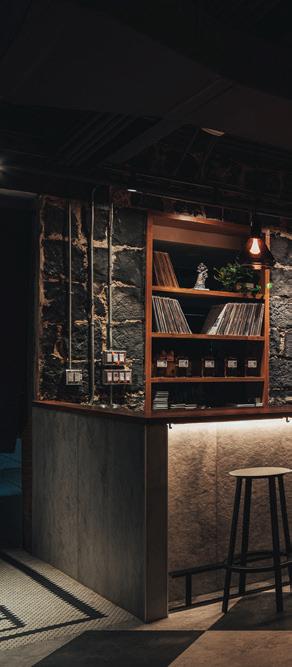
126 | FLUXHAWAII.COM
EXPLORE | DINING
|

the 20th century. By the year 1900, way before plate lunch wagons ever hit Honolulu Harbor, there were already 100 okazuya in Hawai‘i. Some believe because of their resemblance to ekiben vendors, the takeout eateries found in train stations that serve bountiful bentos for extended train rides in Japan, that the concept arrived to the islands with the first Japanese contract laborers who came to work the sugar plantations. As these immigrants left the fields to open their own businesses in the 1920s, many opened what became known as okazuya, local delis that serve pre-made, affordable dishes presented cafeteriastyle, like the since-shuttered Sagara Store in Waialua or the Mōʻiliʻili staple Fukuya, which still has lines out the door at 6:30 a.m. after more than 80 years in business. The concept is unique to Hawai‘i and arouses an enduring nostalgia that was practically begging to be reimagined by a new generation.
Jason Peel, a celebrated chef and driving force behind restaurant openings such as Miro and Papa Kurt’s, decided to serve okazuya classics at his new restaurant Nami Kaze, while preparing to launch a full-service izakaya. As a mixedJapanese Kaua‘i boy, Peel’s childhood is revealed in every bite. “Okazuya is very nostalgic to me,” Peel said. “I’m a white paper box lunch kind of guy.”
As a teen, Peel’s favorite okazuya was across the street from Kauaʻi High School. In his memory the establishment’s name is hazy, but the contents of its white takeout box are as clear as the okazuya’s glass noodles—a thick slice of teri beef, two fried chicken wings, mac salad, salted cabbage, a piece of luncheon meat, and a musubi that stuck to the paper when you tried to pick it up. “Growing up, it was the best,” Peel said.
At Nami Kaze, the fried shrimp and ginger chicken are inspired by Hanamaulu Cafe, the 1920s okazuya landmark on Kaua‘i that closed its doors in 2014. The potato salad made with spaghetti noodles is a version of his 102-year-old grandmother’s recipe and the musubi with fried Göteborg sausage
was inspired by family trips to the beach when he was a kid. When he told me the story, I imagined Peel and his siblings running down to the shore to rinse their hands in the ocean before lunch. “You’d salt your hands and make your musubis,” Peel remembered. “My auntie would fry some salt and pepper chicken, she’d fry up some Göteborg, and it would sit out all day at the beach and we’d eat it all day.”
Peel’s okazuya 2.0 experience also modifies the expectations of the classic business. He does away with the extensive lines that one is notorious for, offering online ordering instead. He also rarely, if ever, runs out of food, and he sources ingredients locally, emphasizing the use of fresh vegetables and seasoning. Laughing, he tells me they use so many Thai chiles that on some days you can “almost die” from the amount of pepper particles swirling in his kitchen. For Peel, it’s a delight to walk into an okazuya and find offerings that “make you remember your childhood,” he says, “but also that’s seasoned!” Intending to push flavor profiles and put a slight twist on dishes, Peel really wants the food to pop.
The most notable update to his neoteric approach, however, is that he makes the food fresh every day in small batches throughout service to maintain quality, saving perfectly cooked food from their slow demise sitting under a heat lamp or in a steam table. “I get so sad when I go,” he reflected on today’s existing okazuya delis, considering sweet and sour spareribs, as an example. “I’m sure when they first make it it’s really good, but I mean the thing’s just sitting there and sitting there … next thing you know you have dry pork.”
Like its predecessors, Nami Kaze serves local Hawai‘i food born out of the plantation era, when workers from an array of ethnic groups began commingling together over meals. More than a century later, Peel’s white paper boxes shine with fresh vegetable namasu, sparkling poke, and kakiage that is actually crunchy.
In postwar 1950s Tokyo, owning records were a luxury. Listening bars,
The DJs, or “sound selectors,” as Miyashiro calls them, curate playlists. The music ranges from jazz and doo-wop to old school hip-hop and classic
128 | FLUXHAWAII.COM

then, offered music lovers a place to relax and listen to jazz or classical music on a proper sound system. Business owners could share their passion with patrons over a cup of coffee or tea at a kissaten, a modest coffeehouse. Over time, venues began staying open later, offering libations, and playing edgier music genres. In Honolulu’s Chinatown, Ryan Miyashiro, Chris Nakano, and Daniel Ng introduced their version of this concept in January 2022 with EP Bar, Hawai‘i’s first listening bar.
Miyashiro was captivated the first time he walked into JBS Bar in Tokyo’s Shibuya district. The tiny bar was packed with records floor to ceiling and a crowd of fashion creatives centered around the bar’s owner, a white-haired man with glasses named Kobayashi Kazuhiro, who was serving drinks and playing ’90s hip hop on two turntables simultaneously. “No requests, even with drinks,” Miyashiro recalled. “He will literally just offer you highballs or beer.”
Miyashiro was most impressed by the record that was playing: “Carmel City” by hip-hop duo Pete Rock & CL Smooth. Seeing someone like Kazuhiro spinning it further floored him. “And in another country?” Miyashiro said. “This wasn’t even New York, this was Japan. I’m like, ‘This is literally the coolest thing I’ve ever seen in my life.’”
At EP Bar, the DJs, or “sound selectors,” as Miyashiro calls them, curate playlists on MasterSounds turntables and mixers. To give an old school look, the owners purchased burnt orange JBL speakers that look vintage, but are built with modern technology and second-hand refurbished 1970s McIntosh amplifier and receiver. The playlists themselves are eclectic, curated, and a Chinatown community affair. Familiar faces from around the neighborhood like Travis Sasaki, the co-owner of Bas Bookstore, and Kamalu Fung, an employee at Sig on Smith, make appearances as DJs, spinning everything from jazz to Hawaiian. The building’s historic brick walls and archways surround two glowing amber shelves of spirits and conjure a medieval feel, perfect for the intimate, den-like atmosphere that EP Bar is going for. Miyashiro gives credit to vinyl listening bars like JBS, a place that personally moved all three owners individually, for inspiring the vibe of EP Bar’s space.
The craft cocktail menu includes highballs created by Justin Park of Bar Leather Apron and Bar Maze, and a signature old fashioned made with black sesame infused bourbon by bar director Sam Trusty. EP Bar tries to stock spirits not every Honolulu bar has such as Four Roses Bourbon and Maker’s Mark 101. “I grew up in
Hawaiian.

130 | FLUXHAWAII.COM

FLUXHAWAII.COM | 131

urban streetwear culture, so I like limited edition things,” Miyashiro explained.
In Japan, many listening bars don’t allow talking or snapping photos, according to Miyashiro. While the intent at EP Bar is for people to sit and listen to the music, its owners know that’s likely not enforceable.
“It’s still America, people do what they want here,” Miyashiro laughed, explaining that no one at EP will scold patrons for chatting with their friends or taking selfies. “We won’t stop you from doing those things, but we’re trying to give you something that’s us. It’s like you’re walking into our home.”
I laughed with Miyashiro, too, but also lament America’s individualistcentric attitudes — the “I’m going to do what I want” credo that can unfortunately prevent Americans from exploring and embracing different ways of being, even in Hawaiʻi. His sentiments around home resonated, though, and it dawns on me that the reason vintage
anything is inherently important is because it paints our past and rekindles joyful parts of us.
It isn’t only that Peel is wistful for the okazuya of his childhood. At Nami Kaze, he has a chance to embody his role as a son, a grandson, and a boy at the beach with his family all at once. At EP Bar, Miyashiro’s recreation of a place and time he loved on a life-changing vacation, did something similar when it transported me back to the hippie-kidpunk-rock-raver-teenage-daughter-ofa-musician I used to be as I sat in one of his barstools. Both joints use modern twists to entice new generations to their spaces, but it’s Nami Kaze and EP Bar’s nostalgic roots that keep you coming back. It’s not just an okazuya, not only a listening bar, but temporal dimensional portals that remind us we’re not simply this present second—we are every memorable meal, song, and moment, carefully collected from the past.
Celebrated chef Jason Peel decided to serve okazuya classics at his new restaurant Nami Kaze.
Both concepts arouse an enduring nostalgia among diners of all ages.
For more details about Nami Kaze, follow their social media at @namikaze.hi; for EP Bar, visit epbar.co.
132 | FLUXHAWAII.COM

EXPLORE
Ka Leo Kēia o Ke Aloha
‘Oiai ke pi‘i nei ka hoihoi i ka ‘ōlelo Hawaiʻi, ma ka pāpaho kūloko ho‘i e ho‘oulu ‘ia ai nā kīpuka e ola makalapua ai ka ‘ōlelo kulāiwi ma waho a‘e o kauhale a me ka lumi papa, wahi a kekahi mea ‘ike o ia ‘oihana i kākau ai. ‘O kinohi wale nō kēia e ho‘omaka ‘ia nei.
KĀKAU ‘IA NA KAHIKINA DE SILVA
PA‘I KI‘I ‘IA NA MAHINA CHOY-ELLIS

Aloha nō kāua e kuʻu makamaka o ke kīleo hoʻokahi, koʻu hoa o ka noho kīpuka ʻana i ka malu o ka ʻōlelo Kanaka. Nīnau ‘ia maila kou mea kākau, i aha lā ka pāpaho ‘ōlelo Hawaiʻi ma ke ‘ano he paepae, he ko‘o, a he lima hānai paha no ka ho‘ōla hou ʻana i ka ‘ōlelo a ko kākou po‘e kūpuna i ke au nei? ‘Oiai he pua kēia na ke kīhāpai o Puahia, kau koke a‘ela ka mana‘o i nā ‘ōlelo akamai i ho‘opa‘a mua ‘ia i nā puke a me nā palapala ‘imi no‘eau. ʻO kā Noenoe Silva ʻapo ʻana i ka ʻōlelo a Benedict Anderson no ia mea he imagined community, i ʻike ʻia ka lilo ʻana o nā nūpepa Hawaiʻi kahiko i wahi e lāhui ai ka poʻe Kānaka Maoli. ʻO kā Leanne Hin ton hoʻi, e aʻoaʻo mai ana aia ke ola o ka ʻōlelo i kona komo ʻana ma nā māhele a pau o ka nohona kanaka, mai kauhale a i ka ʻaha kolokolo, mai ka ʻoihana kālepa a i ke kahua pāʻani, a ma nā ʻīpuka a pau o ko kakou mau hale — ma ka nūpepa, ke kīwī, ke kiʻi ʻoniʻoni, ka puke makekina, a pēlā aku nō. A he mau mea akamai hou aku hoʻi i kū i ka noʻeau.
Eia naʻe, no kēia hui ʻana o kāua i ke kino lahilahi o ka puke nei, e waiho ana au i ia mau leo ma ka ʻaoʻao, a e maliu aku ana i kekahi leo ʻokoʻa. ʻO ka leo ia o ke aloha, ʻo ka leo ia o ke ola, kahi leo e paʻē mau mai ana i kuʻu wahi kumu pepeiao i nā pule i
134 | FLUXHAWAII.COM
| MEDIA |


hala aʻe nei. ʻO ia hoʻi ka leo o ʻAnakala Eddie Kaanana. He kupa ia no nā kaha i kaulana i ka lawaiʻa ʻōpelu, no Miloliʻi. He mau lima nō i huli mau i lalo i paʻa pono ai ke ola o ka lāhui i kona kuaʻana. A he wahi kupuna mānaleo Hawaiʻi i aloha nui ʻia e nā pulapula āna, nā mea hoʻi e hoʻonani mau ana i kona inoa mai Miloliʻi ā i ke awāwa uluwehi ʻo Pālolo. ʻO koʻu mau hui ʻana me kēia kalo kanu o ka ʻāina, he liʻiliʻi wale nō paha, ke helu ʻia a hoʻokūkū ʻia me kā kekahi. ʻO ka ʻono naʻe o ka ʻiʻo i loaʻa maila, he nui nō, ʻaʻole o kana mai. A eia nō ia ke hoʻomau nei i ka hānai ʻana i nei kama. Hoʻomanaʻo aʻela au i kekahi o kēia mau hui ʻana ma ka makahiki 2000. ʻO ia ka manawa i ʻae maila ʻo ʻAnakala Eddie e huakaʻi pū me nā ʻelele o Hawaiʻi nei no ka ʻAha Hoʻolauleʻa i ka Pāheona o nā ʻĀina Pākīpika, ma Kanakī (New Caledonia) e mālama ʻia ai. A ʻo au hoʻi, he lālā no ia hui ma lalo o ka hālau hula a koʻu makuahine. Ma mua iho o ko mākou haʻalele ʻana i ka ʻāina kulāiwi no kahi
moku Kahiki, mea maila kahi ʻAnakala e aho ko mākou hoʻolauna mua ʻana, a ʻike aku ʻike mai i nā hana a mākou e hōʻike aku ana ma ka ʻāina mamao. No laila, ua hoʻolauna pū nō. Hula ka poʻe hula, mele ka poʻe mele, hana keaka ka poʻe hana keaka, a hōʻike mai nā lima noʻeau i kā lākou mau hana noʻeau. A ʻo ʻAnakala Eddie, ua haʻi moʻolelo mai no ia mea he lawaiʻa, e like me ka mea i aʻo ʻia iā ia. Ma waena o kā iala moʻolelo ʻana mai, kiʻi akula ia i ʻelua mau pōhaku ʻiliʻili. ʻEleʻele kekahi, keʻokeʻo kekahi—he koʻa ia. ʻIke maila paha ʻo ia i ka haʻohaʻo o mākou poʻe māʻukaʻuka, no ka mea ua hiki ke lohe ʻia kona ʻeuʻeu, kona kolohe paha i ka nīnau ʻana mai, “A pehea? I mea aha kēia mau pōhaku? Maopopo iā ʻoukou?” Kā! ʻAʻole nō he maopopo iki! “He ʻumeʻume iʻa.” Kāhūhū! Kainō a ʻo ka lāʻau wale nō ke piʻi ona a ka iʻa, eia kā he pōhaku lawaiʻa hoʻi kā ka poʻe kahiko! Eia kā ke kupa i hōʻike maila.
ʻO kēia mau pōhaku ʻelua, no ka lawaiʻa liʻiliʻi ia ma ke kāheka. Ke
‘O Kahikina de Silva lāua ‘o kāna kaikamahine i ke kipa ‘ana i kona ke‘ena ma ke Kulanui o Hawai‘i ma Mānoa.
Visit fluxhawaii.com/ section/olelo-hawaii to read this story in English. This piece is part of Flux Hawaii’s Hawaiian-language reporting series featuring articles conceived, commissioned, and produced all in ‘ōlelo Hawai‘i, in partnership with Google News Lab.
136 | FLUXHAWAII.COM

FLUXHAWAII.COM | 137
hoʻopiholo ʻia kekahi pōhaku, huʻahuʻa maila ke kai, a piʻi nō nā huʻa i luna, ʻo ka hui maila nō ia o nā iʻa o ke kāheka no ka ʻike ʻana i ka mea hou. I ia wā, hiki ke hopu ʻia i ka lima a i ka ʻupena paha. ʻO ka mea ʻāpiki, i loa nō a pau ka huʻahuʻa ʻana mai o ke kai, pau pū ka hoihoi o ka iʻa a hoʻi akula, ʻaʻole lōʻihi loa ka wā e hopu aku ai. Pēlā ia i ke komo ʻana o ka pōhaku ʻeleʻele i kahi kāheka pōhakuhaku, a i ke komo ʻana o ka pōhaku keʻokeʻo i ke kāheka i piha i ke one. Eia naʻe, wahi a ʻAnakala, i hoʻopiholo ʻia ka pōhaku keʻokeʻo i loko o ke kāheka ʻeleʻele, ʻaʻole e hoʻi koke ka iʻa i kona wahi e peʻe ai. Ma muli o ke kūʻokoʻa o ke ʻano o kēia pōhaku, a me kona like ʻole loa me kahi āna e noho nei, ulu aʻela ka hoihoi o ka iʻa a ʻumeʻume maoli ʻia nō e noho ma kahi o kēia pōhaku. Pēlā nō ka pōhaku ʻeleʻele i hoʻopiholo ʻia i ke kāheka oneone o lalo. Pēlā pū paha kēia mea he pāpaho ʻōlelo Hawaiʻi. Ma kēia ʻano kāheka, ʻo ka ʻōlelo Kanaka, ʻo ia ka huʻahuʻa e piʻi mua ai ka hoihoi o ka iʻa e pili mai. A ke piʻi

138 | FLUXHAWAII.COM

FLUXHAWAII.COM | 139
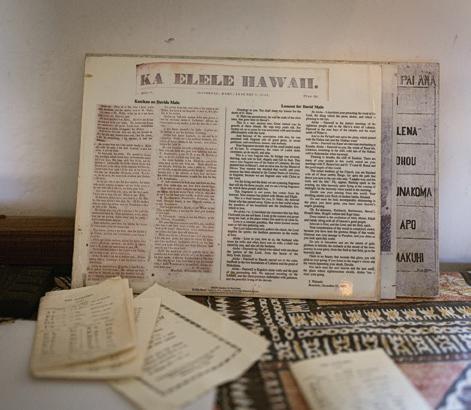
aʻe nei nō. I ka hanakeaka i hui aku nei kākou poʻe iʻa—hui kino aʻela no Nā Kau a Hiʻiaka, hui hou ma ka papakaumaka no He Leo Aloha. I kēlā me kēia pule, launa pū kākou i ka ʻīnika ʻeleʻele o Kauakūkalahale a me ka leo nahenahe o Ke Aolama i loaʻa mai ka nūhou o ka wā nei ma ka ʻōlelo a nā kūpuna. Komo like kākou i ke Kīpuka Leo e hoʻonanea ai i ka leo mele a me ka leo walaʻau maoli o ka Hawaiʻi. A pēlā aku a pēlā aku nō. Lua ʻole ka waiwai o kēia mau hanana, kohu ʻīpuka e hui like ai ka poʻe ʻōlelo Hawaiʻi o kauhale me ko ke ao. Me he mea lā he nohona kīpuka ka nohona Hawaiʻi o kēia au, he keu aku no ka poʻe ʻōlelo Hawaiʻi. Mālama ʻia ka ʻōlelo Kanaka i nā hale o ko kākou mau ʻohana, ma nā kula kaiapuni paha a
me nā papa ʻōlelo Hawaiʻi, akā ke puka kākou i waho o ua mau kīpuka nei, auē! Pā ʻia ka pepeiao i ka namu, ʻo ka hemo paha auaneʻi o ka ʻōlelo mai ko kākou mau waha aku. E ʻole kēia ʻano pāpaho ʻōlelo Hawaiʻi, loaʻa ai kahi e pili pū ai nā kīpuka ponoʻī a kākou a launa like kekahi me kekahi ma ka ʻōlelo a ka poʻe Kanaka. A lilo auaneʻi ko Hawaiʻi Pae ʻĀina i kīpuka e kūpinaʻi ai ka ʻōlelo Hawaiʻi. No laila, ua ʻikea ka pono o ke komo ʻana o ka ʻōlelo Hawaiʻi i nā ʻano pāpaho e kū nei i ka moku, i huʻahuʻa e ʻume i ka iʻa e launa pū. Eia paha ka nīnau i koe—he aha ke ʻano o ka pōhaku nona ia huʻahuʻa? He like a like paha me ke kāheka āna e noho nei? A i ʻole ia, he kūʻokoʻa maoli nō? Aia ke ola o ka ʻōlelo a me ka lāhui i ke kūʻokoʻa.
Pa‘i ‘ia kekahi ‘ao‘ao no ka nūpepa ‘o Ka Elele Hawaii , e hō‘ike ‘ia nei ma Nā Hale Mikioneli (Hawai‘i Mission Houses) ma Honolulu, O‘ahu.
140 | FLUXHAWAII.COM

Sustaining Lei
Maui artisans and flower growers are reaffirming lei’s origins to the land, and along the way, revitalizing the craft in fresh and unexpected ways.
TEXT AND IMAGES BY VIOLA GASKELL
A mark of authenticity in contemporary Hawaiʻi, lei conveys importance. There is an array of occasions that call for such exalted adornments, from birthday parties to peace agreements. But there are two stories of lei today: one of commodification, another of regeneration.
For centuries, lei on Maui was made with foliage, seeds, feathers, and shells found around the island. Today, lei flowers are encased in plastic containers and flown in from Thailand, often stopping in Los Angeles on the way. Garlands of purple and white orchids that are predominately sourced from Southeast Asia are given out by the thousands to tourists each day when they attend a wedding or lū‘au on manicured hotel grounds. And, while imports have increased, Hawaiʻi-grown lei flower sales are less than half of what they were in the late ’90s. Even regal maile is often shipped in from Tonga and the Cook Islands to be worn at wedding ceremonies by unwitting grooms.
However, there is a localized undercurrent in Hawaiʻi’s lei industry powered by emerging lei makers who are eager to reconnect with both the land and culture that has nurtured them. On Maui, a growing group of farmers and artisans are rejecting the prioritization of convenience and unchecked supply for a sustainably foraged, locally grown genre of lei making—the way it used to be.
Haku Maui, Hawai‘i Flora and Fauna, and Waiakoa Wildflowers offer workshops on sustainable lei and lei po‘o. The interest from locals and visitors alike has been heartening. At right, Lauren Shearer in her lei studio.

142 | FLUXHAWAII.COM
EXPLORE | CULTURE |

HAWAI‘I FLORA & FAUNA
Lauren Shearer sees landscapes differently than most. What appears to be a suburban Wailuku roadside is a row of palm bracts waiting to be harvested. An invasive octopus tree, for example, produces a bounty of heʻe berries ripe for lei making. Shearer, who is not Hawaiian but grew up on Maui, is diligent about asking permission and has learned gathering chants to show respect to the ‘āina and the plants she harvests from.
From sunup to sundown, Shearer is immersed in flora and fauna. At her protea petal-strewn studio and lei shop in Hāliʻimaile, she takes apart the otherworldly flowers and strings their parts alongside bisected palm seeds and wild roses to make a lei. She forages the lion’s share of her materials and purchases what she needs from Maui growers and local shops like the Morihara Store, a 90-year-old general store in Kula that carries a coveted local tuberose supplier. Shearer also sources ʻilima and crown flower from the Fukushimas, an elderly couple who grow lei flowers and persimmons on their second-generation Kula farm.
Shearer, who started making lei commercially in 2014, has been stringing her floral creations to adorn friends and family all her life, and still does. But now that she has become something of a floral phenomenon with her inventive, wabi-sabi-esque lei, her creations are given to VIPs at some of Maui’s most illustrious resorts, where she also teaches lei making workshops. In January, she taught a 50-person workshop at the Ritz-Carlton in Kapalua using all foraged flora.
Though Maui residents are still her main clientele, demand from tourists and the hotel industry has been rising year by year. But for now, the order she is most concerned with is a lei po‘o for a fellow plant evangelist who is about to undergo brain surgery. “I’ll be foraging all of the most medicinal plants I know for this one,” she says, “and putting a lot of mana into it.”
Imported Dendrobium orchids may not be disappearing anytime soon, but appreciation for lei harvested, woven, and strung in the islands offers hope.

144 | FLUXHAWAII.COM
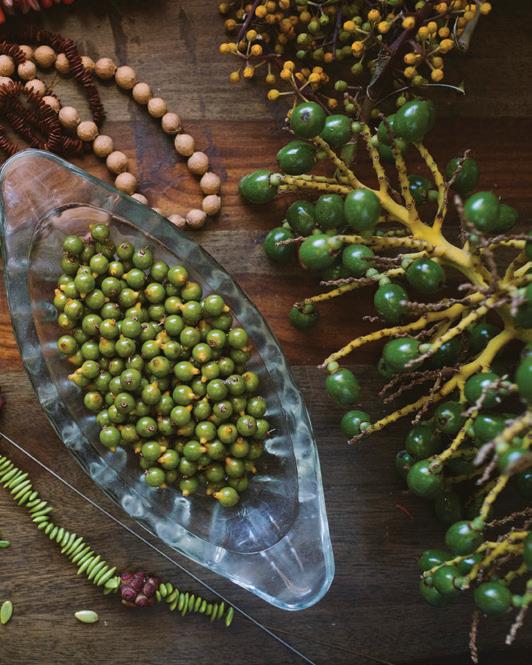
 HAKU MAUI
HAKU MAUI
During her lei and lei poʻo workshops, Britney Texeira tells her guests that when you wear lei around your neck, it resembles the way a child would embrace their mother.
“That’s how much love goes into this,”
Texeira tells them. Because, for locals, lei can be interpreted as “a sign of life, almost like an umbilical cord,” she continues. “It’s an extension from oneself or one’s place to another. The next time you see a lei or receive a lei, just take that in for a moment.”
Growing up, Texeira’s family taught her to string lei, but it wasn’t until 2016 when she left the hotel industry to look for a more fulfilling professional path, that she started to make lei in earnest. “I just started gathering,” she says. Texeira wandered the property at her grandmother’s home, picking plumeria, tī leaves, pakalana, and other alluring plants, and made lei while she contemplated her next move, which it turned out, was right in front of her. Texeira says that through her customers she has developed a more nuanced view of people’s interest in lei. Locals often come to her workshops to acquire the elementary lei making skills they’ve longed for. “There was a time when Hawaiian culture skipped a generation, where the goal was to Americanize,” Texeira explains. “But now that generation, they are parents, and they have keiki or grandparents who they
want to be able to give lei to by making it themselves.”
Tourists, meanwhile, who either seek out her workshops or wander into the shop, are often eager to understand lei’s significance beyond its functions in five-star hotels. “There’s this new wave of educated tourists who do their homework before they get here and they want to be respectful and correct,” she says.
Texeira runs her business with her mother, Sheryl Fishell, and best friend, Celina Bailey, from a charming shop and workspace in Makawao, the paniolo town where she grew up picking her tūtū’s flowers. As her business expanded, Texeira started sourcing beyond the family’s yards, but she only buys from Hawaiʻi growers: orchids and anthuriums from Greenpoint Nurseries in Hilo, ginger from Kaeleku Tropicals in Hāna, and protea and other flora from Malolo Farm in Kula and Anuhea Flowers in Olinda. She grows palapalai, pōhinahina, maile, and ‘a‘ali‘i at her home in Pukalani and still picks ferns, tī leaves, and pakalana from her grandmother’s yard. Acquaintances with desirable foliage in their yards occasionally drop by unannounced when they have an abundance of a particular plant; during jade season, Texeira sometimes finds a vine of the opulent blue plant left hanging on her shop gate.
Lei making as Native Hawaiians originated the custom is inherently more sustainable than the current economic model that the hospitality industry dominates. Ecoconscious lei makers are directly rebutting that supply-chain. At right, the lei maker Britney Texeira.
146 | FLUXHAWAII.COM

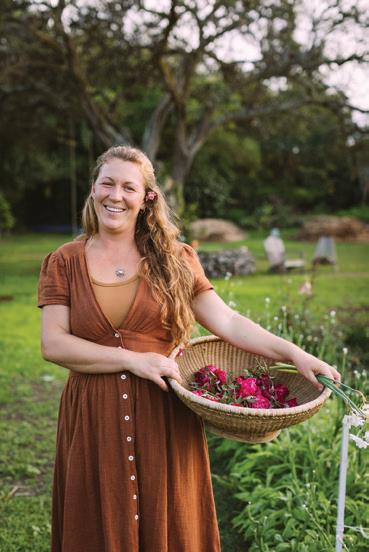 Tessa and Zena Kreider of Waiakoa Flowers in Kula, a dry, temperate part of Maui situated 2,500 feet up the leeward slope of Haleakalā.
Tessa and Zena Kreider of Waiakoa Flowers in Kula, a dry, temperate part of Maui situated 2,500 feet up the leeward slope of Haleakalā.

Disillusioned by the wastefulness they’ve seen in Maui’s professional floral industry, the sisters made it their goal to do everything in house.

WAIAKOA WILDFLOWERS
Tessa and Zena Kreider appear to be naturals when it comes to bending European cut flowers to their will. Lilies and chrysanthemums grow in the shade of wind-warped kiawe trees on the sisters’ family property within the Waiakoa ahupua‘a in Kula, a dry, temperate part of Maui situated 2,500 feet up the leeward slope of Haleakalā.
But they will be the first to admit that their flourishing garden came from years of trial and error. “I am married to my garden,” Zena explains. “I have a friend who says, ‘the best fertilizer is the farmer’s shadow,’ and it’s true. Presence is key with growing anything.”
After high school, the two siblings moved to California to study art and leatherwork, but when they returned to Maui in 2012, they ended up using the lei and haku making skills they learned from their hula hālau, right up the road. Their labor of love began with a small memorial garden for
their father, sewn with cosmos (his favorite flower and the name of their pet deer). They started sending a handful of bouquets to the farmers market with Zena’s partner, who farmed vegetables. And as the garden grew, their passion matured into a business of made-to-order lei and bouquets, and workshops on the farm.
Disillusioned by the wastefulness they’ve seen in Maui’s professional floral industry, Tessa and Zena made it their goal to do everything in house. They use upcycled silk ribbon to make their lei poʻo and natural string for their lei. Their “everlasting” lei poʻo, a mixture of strawflowers, statices, and other plants that dry intact, are made to last for years. On their dreamy property, once a dry patch of dirt dotted with thorny brush, silvery hinahina now hangs from kiawe branches amongst thickets of lokelani rose, and ‘āhinahina and ʻaʻaliʻi, sapling natives the sisters planted to use in their lei.
From birthdays to graduations, lei bestows an honorific aura on any occasion in Hawai‘i.
Find these lovely lei makers at hawaiiflorafauna.com, hakumaui.com, and waiakoawildflowers.com.
150 | FLUXHAWAII.COM

 The inside of a Honolulu teahouse mid-ceremony. Image by John Hook.
The inside of a Honolulu teahouse mid-ceremony. Image by John Hook.
LIVING WELL
“The same is true of ‘āina’s own memory of a time precontact—divergent realities that coexist simultaneously, to be acknowledged, resisted, or coaxed back into being.”—Timothy
A. Schuler

The Past is Present
With Hawaiʻi Non-Linear, Sean Connelly and Dominic Leong work to unearth alternative futures for Hawaiʻi’s built environment.
TEXT BY TIMOTHY A. SCHULER
IMAGES COURTESY OF HAWAI‘I NON-LINEAR
For a decade, the O‘ahu-born artist and designer Sean Connelly has employed the tools of architecture to make art that challenges Western, colonial understandings of land. His 2013 installation, “A Small Area of Land (Kaka‘ako Earth Room),” a towering, monolithic slab of compacted soil and sand, was a critique of how land in Hawaiʻi has been commodified since the Kuleana Act of 1850. Since then, Connelly’s work has become increasingly phantasmagoric, blurring the line between architecture, cartography, visual art, and film. In “O‘ahu, A Giant Military Base,” part of a larger, in-progress work, Israel Kamakawiwo‘ole’s “Somewhere Over the Rainbow” plays as a satellite image of Oʻahu morphs into a grotesque, almost cartoon-like collage of giant artillery shells, exploding ordinances, radar systems, and floating military logos—the island’s volcanic topography dwarfed by these oft-concealed infrastructures of war.
Now, Connelly has teamed up with New York-based architect Dominic Leong, an assistant professor of architecture at both Columbia University and MIT, to found Hawaiʻi Non-Linear, a trans-oceanic, queer- and indigenous-led architectural collaborative whose mission is to “create art and architecture for ‘āina.” (With his brother, Chris, Leong also runs the celebrated New York practice Leong Leong, perhaps best known for the Los Angeles LGBT Center’s Anita May Rosenstein Campus, a collection of clean, white volumes so light and airy that they feel weightless.) With a goal of bridging the worlds of art, architecture, and activism, Hawaiʻi Non-Linear was founded as a nonprofit collaborative to help advance environmental justice and Native Hawaiian knowledge. As a practice, it straddles multiple disciplines and geographies, operating both within the rarefied world of East Coast
Still from Hawai‘i Non-Linear’s short film “A JusticeAdvancing Architecture Tour” (2021).

154 | FLUXHAWAII.COM
LIVING WELL | ARCHITECTURE |

FLUXHAWAII.COM | 155

architectural education and on the ground in Hawai‘i. Connecting its various modes are two braided beliefs: one, that architecture is political; and two, that Hawaiʻi has more to offer the field of architecture than scholars historically have assumed.
The collaboration was born out of the social unrest of 2020. For Leong, who grew up in Northern California, regular visits to extended family on O‘ahu were formative in engendering a deep and sustained relationship to Hawai‘i. “At the time, these experiences and connections weren’t articulated as part of a ‘cultural resurgence,’ they were just a way of life that was a mixture of my Chinese and Hawaiian roots through my father—embodied stories of surviving and thriving in the wake of colonialism, plantation life, and U.S. statehood,” Leong says. Amid the institutional reckoning that followed the murder of George Floyd in 2020, Leong says he felt that he had a “specific responsibility within the architectural discipline, as [a part of the] Kānaka Maoli diaspora, to help
pluralize the canon and articulate a more enriched understanding of architecture that is not limited by a Eurocentric legacy.” Leong became particularly interested in the history of urbanization in Hawaiʻi. It wasn’t long before his research led him to Connelly. “I was really struck by the intersections he was working at, in terms of activism, urbanism, all these things,” Leong says. Meanwhile, Connelly had become increasingly disillusioned with Hawaiʻi’s architecture community, which he saw as unwilling to grapple with the history of U.S. imperialism in Hawai‘i. “When Dominic reached out it was like a beam of light,” Connelly says.
In Fall 2020, Leong and his brother invited Connelly to co-teach a design studio at Columbia based around Connelly’s Ala Wai Centennial Memorial Project, a proposal to incrementally reclaim Waikīkī— and eventually the entire ahupua‘a—for more regenerative and just uses. “I felt that it was both personally and professionally important to support Sean’s work in the
Stills from “A JusticeAdvancing Architecture Tour” (2021). What begins as an architecture documentary becomes a hallucinogenic meditation on death, dispossession, and cultural erasure.
156 | FLUXHAWAII.COM



context of architectural education,” Leong says, and to expose students “to a deeper analysis of the connections between the history of colonialism and U.S. urbanism in Hawaiʻi.”
One of their first collaborations outside of the classroom is an experimental short film whose tone and visual style blend documentary and horror. Titled “A Justice-Advancing Architecture Tour,” the film juxtaposes the Hawaiʻi State Capitol Building—“the single-most dominant work of public architecture in the state of Hawaiʻi,” according to the National Register of Historic Places—and ʻIolani Palace, the seat of Hawaiʻi’s monarchy until the Overthrow in 1893 and at the time one of the most advanced buildings in the world. What begins as a diagrammatic dissection of the capitol building’s design, complete with slow pans worthy of the most polished architecture documentary, devolves into a hallucinogenic meditation on death, dispossession, and cultural erasure. “Contrary to popular architectural
interpretation and belief,” Connelly intones, “the Hawaiʻi State Capitol Building isn’t just modernism. It’s militarism. It’s desecration.” Foundational to Hawaiʻi Non-Linear’s approach to architecture is the notion that history is ever-present. The name is a nod to Hawaiian cosmology and to the concept of time as a fluid, folded, and fungible thing. Through this lens, the U.S. military’s occupation of Hawai‘i is not in the past but rather exists continuously, dynamically in the now. The same is true of ‘āina’s own memory of a time precontact—divergent realities that coexist simultaneously, to be acknowledged, resisted, or coaxed back into being. Through its work in and outside of the architecture profession, Hawaiʻi Non-Linear is attempting to make visible — and real — the latent futures that exist all across Hawai‘i. It’s a project with global significance, Leong says. “Hawaiʻi is such an acute example of settler colonialism and these larger patterns that get played out all over the place. That’s why Hawaiʻi is so important to understand on a global level.”
Hawai‘i Non-Linear’s founders have advocated for the interruption of historic development patterns, beginning with the Ala Wai watershed.
Hawai‘i Non-Linear is a trans-oceanic, queer- and indigenousled architectural collaborative.
158 | FLUXHAWAII.COM

Keiki Advocates
Hawai‘i Children’s Action Network is building an army of advocates in the fight for a better future for Hawai‘i’s keiki.
TEXT BY LINDSEY KESEL
IMAGES COURTESY OF HAWAI‘I CHILDREN’S ACTION NETWORK
With the mantra, “But first, nā keiki,” Hawai‘i Children’s Action Network (HCAN) is working to improve the well-being of Hawai‘i’s youth by taking a hard look at the persistent social conditions that threaten their success. The nonprofit’s growing network of parents and community partners seek to diminish poverty, health disparities, lack of education, and other effects of systemic oppression that have traditionally hit Native Hawaiian and Pacific Islander children the hardest.
Founded in 1996, HCAN is Hawai‘i’s only 501(c)3 nonprofit advocating solely for local children—a purpose that has become increasingly vital as the state continues to underperform in national child-related metrics. In the fall of 2020, Aloha United Way reported that one in seven local households with children don’t have enough food to eat, and one in four are afraid they won’t be able to make their next housing payment. In the recently released 2021 Kids Count Data Book, a report by the Annie E. Casey Foundation that studies how families across the nation are faring, the economic well-being of Hawai‘i’s keiki ranks 44th, falling 14 spots over the course of a year.
For Deborah Zysman, HCAN’s Executive Director, leveling the playing field for underserved youth means standing up for equity in addition to equality. “It’s not enough to treat all children equally,” she says. “To right our societal injustices — and truly give every child an equal opportunity for success — we have to target our public resources toward children who are systemically oppressed and disadvantaged from the moment they’re born.” To that end, HCAN projects are designed around researching and tracking disparities, advocating for solutions, and supporting people to be changemakers for their community.
One of the organization’s most vital causes is championing high-quality early learning in Hawaiʻi, where parents pay an average of $14,000 a year for center-based infant care. In 2020, HCAN helped pass a bill that broadens eligibility for the Preschool Open Doors Program and creates a state goal of giving all 3- and 4-year-olds access to pre-Kindergarten by the year 2032. More recently, teams have rallied in support of the federal efforts to make early learning programs affordable or even free—a potential game-changer for families.
At the onset of the COVID-19 pandemic, HCAN’s swift ability to mobilize citizens fostered stability in a time of upheaval. In partnership with the Hawaiʻi Working
Families Coalition, volunteers launched a campaign asking policymakers to dedicate a portion of the CARES Act coronavirus relief funds to help vulnerable families. Thanks in part to a socially distanced capitol rally, digital action alerts, widespread media coverage, and other campaign efforts, the Hawai‘i State Legislature allocated $15 million to help childcare centers safely reopen and remain operational.
In mid-2020, HCAN created the COVID-19 Data Dashboard and Resource Map, a valuable mobile-friendly website that kept families informed about food, financial assistance, childcare, and emergency legislation for paid leave benefits. Today, the HCAN website features a condensed version of the resource map that provides visitors with information on vaccination and testing sites, vaccination locations for children, and updates on pandemic- related financial aid. Website visitors can also check the Household Pulse Survey Dashboard, which uses U.S. Census Bureau data to share statistics on income loss, food sufficiency, health care, and childcare disruptions, spreading awareness on the myriad of ways that the pandemic is affecting local households.
With a gradual return to normalcy in Hawai‘i on the horizon, HCAN staff and volunteers are taking time to celebrate the progress of the last two years. Their annual Champions for Children fundraiser set for April recognizes community leaders and superhero supporters who have gone above and beyond to promote keiki wellness. Also coming up in 2022, HCAN will host a series of new Keiki Talks, where researchers present the latest insights on children’s issues. Past topics of intrigue include “The Pandemic and Young Minds” and “Helping Your Kids Heal from Racism.”
As Zysman hunts for new ways to transform the lives of Hawaiʻi’s children, she hopes more parents, grandparents, and caregivers will use the tools of democracy to “dream bigger and do better for families.” To help demystify the civic process, HCAN sends out action-alerts around critical family-focused legislation, shares tips on how to submit testimony, and offers a free civic engagement program called the Parent Leadership Training Institute.
“It’s ok to feel frustrated or disenfranchised with the broken system,” says Zysman. “Now more than ever, parent power is critical to finally seeing the change we want to see, and creating the Hawaiʻi our children deserve.”
LIVING WELL |
PROMOTIONAL |



Hawai‘i Children’s Action Network is building a grassroots movement fighting to ensure Hawai‘i’s keiki are healthy, safe, and ready to learn.
HCAN congratulates this year’s Champions for Children awardees, who have gone above and beyond to make an impact for Hawai‘i’s children, families, and communities. Mahalo also to the Champions for Children sponsors whose support is making a difference for keiki. See the full list of awardees and sponsors at champions.hawaii-can.org.
Founded in 1997, HCAN is a 501(c)(3) nonprofit and the only one in Hawai‘i solely committed to advocating for children. HCAN addresses the root causes of poverty and inequity and develops public policies that help children and their families.
The Way of Tea
A woman’s journey into the lifechanging world of Japanese chado.
TEXT BY RAE SOJOT
IMAGES BY JOHN HOOK
Tucked into a quiet hilltop neighborhood in Honolulu, Yumiko Sayama’s tea house is a study in grace and purpose. Birds warble sweet notes from the trees as the morning’s sunlight filters in through the house’s translucent shoji screens. Inside, clean lines and muted colors soothe an overactive mind. Beauty is found in the small, unadorned details: neutral walls edged with simple wood trim, a vessel holding water, a single scroll. Even the breeze, winding its way through the ironwood tree forest adjacent to Sayama’s home, seeks brief respite before traveling on to the city below. Everything quiets in the tea house.
Sayama is a teacher—or a “lifelong student,” she demurs—of the art of chado, or “the way of tea.” Clad in kimono, she prepares for the morning’s tea ceremony with movements both silent and sublime. Believed to have originated in the late 12th century, when a Japanese monk returned from China with new knowledge of tea preparation, the tencha tea ceremony has evolved into an elegant art that embodies the quiet contemplation of Zen Buddhism through grace, harmony, and humility.
Sayama arranges cylindrical pieces of charcoal in a hearth, their embers glowing in the silky ash. She prepares the implements for the ceremony: palm-sized tea bowls, a slender, elongated ladle, an airy bamboo whisk—each item utilized with exquisite thought and care. Seated upon pale-golden tatami mats, guests enjoy wagashi, or Japanese confections, while Sayama adds a small spoonful of moss-green powder into a bowl. She adds hot water and briskly whips the mixture. From the elegant crenellations of her kimono, she removes a red silk square to handle the tea bowl. The wagashi, having left a trace of sweetness on the tongue, balances out the bitter foaminess of the matcha tea that Sayama now presents to the guests. Chado is beautiful to observe, explains Sayama, and not just for its refined prescribed
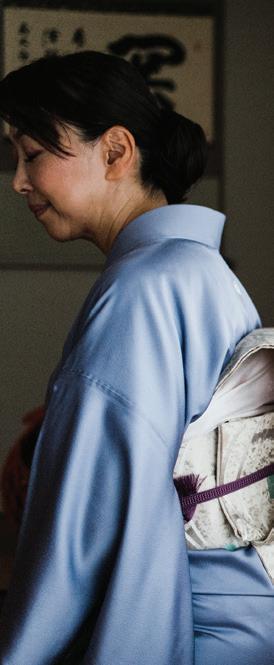
162 | FLUXHAWAII.COM
LIVING WELL |
|
CEREMONY

motions or the simplistic beauty of its ceremonial implements. “Tea is always about taking care of others,” she says.
Growing up in Asakusa, a Tokyo district known for retaining a historic Japanese atmosphere, a young Sayama took curious delight in seeing the townswomen eschewing modern, Western clothing in favor of traditional Japanese dress and hairstyles. She’d watch them mete graceful steps along neighborhood corridors. Donning a kimono as a child, she felt special, as if a “princess.” Once in the fourth grade, she even styled her hair in the same delicate manner as the women she had admired in the streets. “I just felt comfortable,” Sayama says. Though Sayama appreciated the classic Japanese arts, studying Japanese dance late into her teens, chado held little appeal. In Sayama’s mind, tea ceremonies seemed too rigid and regulated. Seiza, the formal, upright style of sitting found in tea ceremonies, seemed a dreadful requirement. By the time she was 31 years old, Sayama resided on O‘ahu, where she was

164 | FLUXHAWAII.COM

acclimating to tropical life in the Pacific. In quiet moments, she found herself missing her home culture. Longing to reconnect, she telephoned a local Hongwanji: Were there any classes available, perhaps ikebana or Japanese dance? The woman on the line was obliging, the call serendipitous. Indeed, a tea class was scheduled for that very morning.
At the class, unlike the formal, constricted tea room she had imagined in her youth, Sayama instead discovered a warm, cheery salon of women. The group chatted about soap operas and new restaurants while simultaneously learning about tea ceremony protocol. Though the tone leaned more casual than ceremonial, Sayama found the practice pleasing and began regularly attending the gatherings.
Ten years later, Sayama’s teacher, who had been quietly observing Sayama’s inclination toward chado, encouraged her to visit Kyoto— considered the hub of Japanese tea culture—to further her tea studies. There, Sayama experienced a world strikingly more formal than her relaxed Honolulu-based classes. “It was so hard,” says Sayama, noting that many of the workshop participants had been practicing chado for more than 30 years. “I was a beginner, like a chick!” When Sayama began to struggle, and her prejudices of tea’s rigid culture surfaced anew, the teacher gently demonstrated to her that chado was not meant to be constrictive. “You don’t have to do it,” Sayama was told. “There is no ‘have to.’” Suddenly she understood: Chado wasn’t about rules; it was about finding rapture through meditative action. “It was like opening a treasure box,” Sayama says of the awakening. “Once you understand the basics, it’s freeing. I felt reborn.”
Between her visits to Kyoto and her continued study in Honolulu, Sayama’s connection to chado deepened. Then, 25 years into her tea journey, Sayama was offered a most prestigious honor: a scholarship to study under a renowned tea master in Kyoto.
“It was sort of like boot camp,” Sayama says of the strict, yearlong study. During it, she led a cloistered life. Sayama and the four other awardees were required to wear kimono every day. Scholarly endeavors and mundane work were prescribed in equal measure. Days began promptly at sunrise, with two hours dedicated to cleaning the grounds, including the bathrooms, kitchen, and gardens. After a morning assembly, a full day of classes commenced, followed by dinner and more cleaning. Students finally retired to their sleeping quarters at 9 p.m. Nearly three years later, Sayama marvels at the experience, grateful for having furthered her knowledge in both breadth and depth, but more so, grateful for having what began as a recreational pleasure transcend to something more spiritual.
Sayama sometimes fears that technology has dulled our senses. Fortunately, in a teahouse, the high-tech world outside is absent. Guests are invited to slow down and experience the world around them. While in Japan, where the four distinct seasons—winter, spring, summer, and fall—heavily tie into tea ceremonies, Sayama has instead discovered ways to highlight Hawai‘i’s own unique patterns in nature. “I try to show [my guests] how we can feel seasons in other ways,” she says. “For example, see how the moon is so bright right now, or how the shower trees bloom.”
In Sayama’s teahouse, guests can refresh and reset. Then they bow in appreciation to their hostess, and the shoji screens are opened anew. The tea ceremony is now complete. Outside, the sun shines in a wide blue sky. The guests inhale a final, restorative breath before departing.
“This is a lifelong study,” says the Honolulu tea teacher, reflecting upon chado’s impact on her spirit, outlook, and direction in life. Through chado, she found passion. Through passion, she found purpose. And, through purpose, Yumiko Sayama found her way.
Sayama is also a teacher of the art of chado, or “the way of tea.” At right, one of her students.
166 | FLUXHAWAII.COM

Rooftop 102
N. Hotel
POEM BY TONY KILE
laying on my back, i can’t determine if it’s you, or the evening sky that’s more beautiful or even which of you has more color.
 ART BY TAYLOR OISHI
ART BY TAYLOR OISHI
| A HUI HOU | 168 | FLUXHAWAII.COM































 Viola Gaskell
Viola Gaskell

 Lindsey Kesel
Lindsey Kesel

 Carissa Moore is the first female Olympic gold medalist for surfing. Image by Steven Lippman.
Carissa Moore is the first female Olympic gold medalist for surfing. Image by Steven Lippman.










































 ‘Ohe kāpala, or bamboo stamps, are used in stamping kapa. Image courtesy of Lehuauakea.
‘Ohe kāpala, or bamboo stamps, are used in stamping kapa. Image courtesy of Lehuauakea.










































 The interior of EP Bar in Chinatown, O‘ahu. Image by Mark Kushimi.
The interior of EP Bar in Chinatown, O‘ahu. Image by Mark Kushimi.




















 HAKU MAUI
HAKU MAUI

 Tessa and Zena Kreider of Waiakoa Flowers in Kula, a dry, temperate part of Maui situated 2,500 feet up the leeward slope of Haleakalā.
Tessa and Zena Kreider of Waiakoa Flowers in Kula, a dry, temperate part of Maui situated 2,500 feet up the leeward slope of Haleakalā.



 The inside of a Honolulu teahouse mid-ceremony. Image by John Hook.
The inside of a Honolulu teahouse mid-ceremony. Image by John Hook.
















 ART BY TAYLOR OISHI
ART BY TAYLOR OISHI

